
The Leading Source of Insights On Business Model Strategy & Tech Business Models


Apple Marketing Mix Case Study
From one juggernaut to another, now we will describe Apple’s marketing mix according to product , price , promotion, and place.
Table of Contents
Apple’s product mix is mostly confined to consumer electronics and online services. As is the case with Amazon, however, Apple is expanding into other industries.
The current product mix consists of:
- Wearables, Home, and Accessories – such as Apple TV and Apple Watch.
- Advertising.
- Digital Content.
- Payment Services, and
- Cloud Services.
Most of these products form part of the Apple ecosystem that supports the company’s competitive advantage and makes each product more attractive to consumers.
In other words, Apple products sync with each other so consumers can easily copy media and other preferences across multiple devices.
Apple’s pricing strategy relies on product differentiation. With a proven track record of innovation and stable consumer demand, the company has power over its pricing .
New product launches are invariably hyped, which means Apple can focus on selling its products for a premium price instead of increasing unit volume.
The company also designates a minimum advertised price (MAP) to prevent retailers from selling its products below a certain amount.
This protects profits and, to some extent, increases the brand ’s prestige and the desirability.
Apple also utilizes price skimming.
This involves setting a much higher price for new model releases before gradually lowering it over time as each model is superseded.
Apple’s ability to market and promote its products is almost as legendary as its ability to innovate. Its marketing strategies focus on the power of simplicity in product form and function.
Simplicity can also be seen in the way that Apple structures the ads themselves.
They tend to be “to the point” and do not contain irrelevant information while still making an emotional connection with the target audience.
The company also loves to mention its superior user experience, whether that be its immersive product ecosystem or the professional customer service and visual layout of an Apple store.
In terms of building its brand organically, Apple relies on positive review building and subtle product placement in movies.
The company also markets its new products via traditional channels such as television, billboards, and print media.
But in line with its pricing strategy , Apple products are never promoted on sale or as part of a limited-time offer.
Apple utilizes multiple avenues to reach customers and make its product more visible on the global stage. These include:
- Apple stores – these stores embody the Apple brand and are placed in strategic locations with high foot traffic. Stores are designed in such a way that consumers can freely interact with demo products and Apple support staff. There are now approximately 518 stores in 25 countries around the world .
- Online stores – for those who prefer to order their products online or do not have access to an Apple store nearby.
- Retailers – countless retail businesses are also authorized to sell Apple products and services. These include many consumer electronics retailers, telecommunications companies, and department stores.
- Authorized enterprise resellers – these entities provide procurement, deployment, app development, and other services that help enterprises incorporate Apple products within their organizations.
Read Next: Marketing Mix , Apple Business Model
Related to Apple
Who Owns Apple

- Apple Business Model

Apple Business Growth

Apple Distribution

Apple Value Proposition

How Much Is Apple Worth?

Apple Cash On Hand

Apple Employees

Apple Revenue Per Employee

Apple iPhone Sales

Apple Profits

Revenue Per Employee

Apple Mission Statement

The Economics of The iPhone

Tim Cook’s Salary

Tim Cook’s Net Worth

Smartphone Market Share US

- Apple Distribution Strategy
- The Apple-NeXT Deal
- A Decade-Long Evolution Of Apple Sales By Products
- Who Owns Apple?
- Apple vs. Google Business Models
More Resources
![Space As A Service (SPaaS) Business Model [WeWork Case Study] space-as-a-service-model](https://i0.wp.com/fourweekmba.com/wp-content/uploads/2019/08/space-as-a-service-model.png?resize=150%2C110&ssl=1)
About The Author
Gennaro Cuofano
Discover more from fourweekmba.
Subscribe now to keep reading and get access to the full archive.
Type your email…
Continue reading
- Panelist area
- Become a panelist
Marketing Mix: definitions, analysis examples [Complete Guide 2023].
The marketing mix aims at making your marketing positioning concrete . Often associated with the term “ 4Ps “, the objective of the marketing mix is to make your positioning tangible each time your brand is in contact with the consumer (the so-called “touchpoints”).
This article explains the difference between 4P and 7P , explains each facet of the marketing mix with numerous examples , and ends with a detailed case study .
To go even further, we suggest you consult our online resource , where we detail and illustrate all the factors to study for each of the 7Ps. We have also published case studies analyzed according to the 7Ps: Rimac electric car , high-end watchmaking , fruit juice , cosmetics .
Finally, don’t miss our free pdf marketing mix guide with tons of exemples. It’s free to download.
- The 4P: definition
- Difference between 4P and 7P
- P1: Product
- P3: Promotion
- P6: Process
- P7: Physical Evidence
- Complete case study (Ryanair)
- Marketing mix guide (free download)
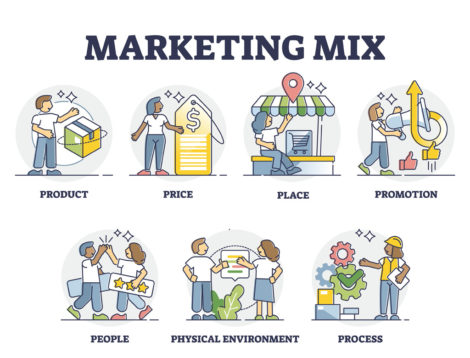
Marketing mix: what are the 4Ps?
The term “marketing mix” is often associated with another acronym: the 4Ps. The two have become almost interchangeable since Philip Kotler popularized the concept. “4Ps” is the English acronym for the 4 operational facets of marketing that make your company’s positioning a reality. They all begin with the letter “p” in English:
- “Product” : all aspects related to the product (the Product Policy)
- “Price” : the price positioning of your product concerning its competitors (the Price Policy)
- “Promotion” : the aspects related to promotion such as advertising or the ways to make people aware of the existence of the product (the Communication Policy)
- “Placement” : aspects related to the distribution of your product (the Distribution Policy)
If Kotler popularized the 4Ps, its paternity goes to E. Jerome McCarthy (1960) . The latter’s genius was to summarize these 4 facets in the form of an acronym that has now become part of everyday marketing language. Since the 1970s, however, marketing has evolved considerably. The 4Ps have become, if not obsolete, at least seriously incomplete. In the 1980s, marketing theorists called for a revision of the 4Ps, leading to the birth of the 7Ps .
History: how the marketing mix went from 4Ps to 7Ps
- In 1960, McCarthy invented the 4P model (Product, Price, Place, Promotion)
- In 1987, Judd proposed a “human” component in the form of a fifth P (“people”).
- In 1986, Kotler added “political power” and public opinion (“public opinion formation”)
- It was in 1980 that the 7Ps took shape. Booms and Bitner proposed to add three “P’s”: “people” (to cover the human aspects of relationship marketing), “physical evidence” (a material component of the service), and the “process” part (interaction with the service user).
Marketing mix: what is the difference between the 4Ps and the 7Ps?
Digitalization has made the 4P’s seriously outdated. The 4Ps were indeed well adapted to a “physical” world but much less to e-commerce. They have therefore been supplemented by 3 new “P’s”:
- People : aspects related to human interactions through the multiple channels available today (primarily digital)
- Process : the processes put in place to guide interactions, especially those related to services.
- Physical Evidence: the tangible elements put forward to convince the customer (sales outlet layout, customer reviews, etc.)
To help you implement the marketing mix, we have prepared a detailed example at the end of this article.
A recent example (2023): the collaboration between Yayoi Kusama and Vuitton
The famous Japanese artist collaborates once again in 2023 with Louis Vuitton. This collaboration allows us to illustrate several facets of the marketing mix:
- Physical evidence : the Vuitton flagship store, already famous for its spectacular window displays , is adorned with a unique ephemeral decor. The facade is studded with round motifs, symbols of Yayoi Kusama’s work, and a huge inflatable effigy in her image.
- Product : the collaboration is realized through a special edition of the famous Vuitton bag. The monogrammed canvas is adorned with round patterns. This is not the first time that Vuitton has carried out this kind of collaboration. We will remember, for example, the one conducted with the article by Jeff Koons.
- Promotion : this collaboration is making news, which results in a spectacular staging of the sales outlet on the Champs-Elysees and a limited edition product. This operation can, therefore, also be analyzed from the perspective of the Promotion P.

Vuitton’s flagship store on Avenue des Champs Elysées in Paris, photographed in February 2023 during the collaboration with Yayoi Kusama.

The P in “Product” (Product Policy)
The first of the 7Ps is, of course, the product . The term product does not mean only a physical object. It can also be a service.
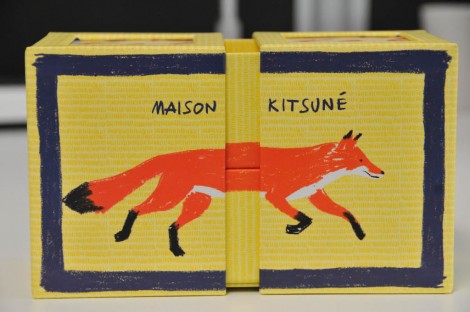
The chocolate maker Pierre Marcolini had materialized its collaboration with Kistuné by very original packaging.
To cover this first “P,” you will have to describe the product’s characteristics (design, packaging, functionalities), its place in the range, as well as the services that are attached to it (after-sales service, repair, end-of-life recycling).
Try to explain the characteristics of the product that make it different, unique, and that are part of its identity.
Also, think about the packaging, which is often an integral part of the customer experience , as it is at Apple.

The P in “Price” (Pricing Policy)

In the marketing mix of luxury watch brands, the pricing strategy is “value-based.” The price is determined according to the value perceived by the customer and is not the sum of the price of the components used.
The second of the 7Ps is central since it is about price.
Here, the aim is to describe how the company manages the different facets of “price” in its market . This starts with a description of the pricing strategy adopted by the company. The most well-known are the following:
- costs + margins: you add a margin to your production costs
- value-based: the price is determined according to the consumer’s perception of value
- competitive: you realize using the competition research and fix your price according to one of your competitors
The pricing strategy, once determined, will have to be declined in a “ price tactic .” The pricing tactic is the operational extension of the pricing strategy. It describes how, in concrete terms, the pricing strategy is applied in the field. In this respect, the strategy of Swiss watchmakers is fascinating. They create a shortage that supports demand by voluntarily limiting production and choosing to whom they want to sell. Some, like Patek Philippe, also support the price level by buying back their older models at a high price to increase their desirability. The price of the products then soars on the parallel market, creating speculative bubbles like the one we described in this survey. The graph below shows the effect of the pricing tactics of Rolex, Audemars Piguet, and Patek Philippe on the price of their men’s watches.
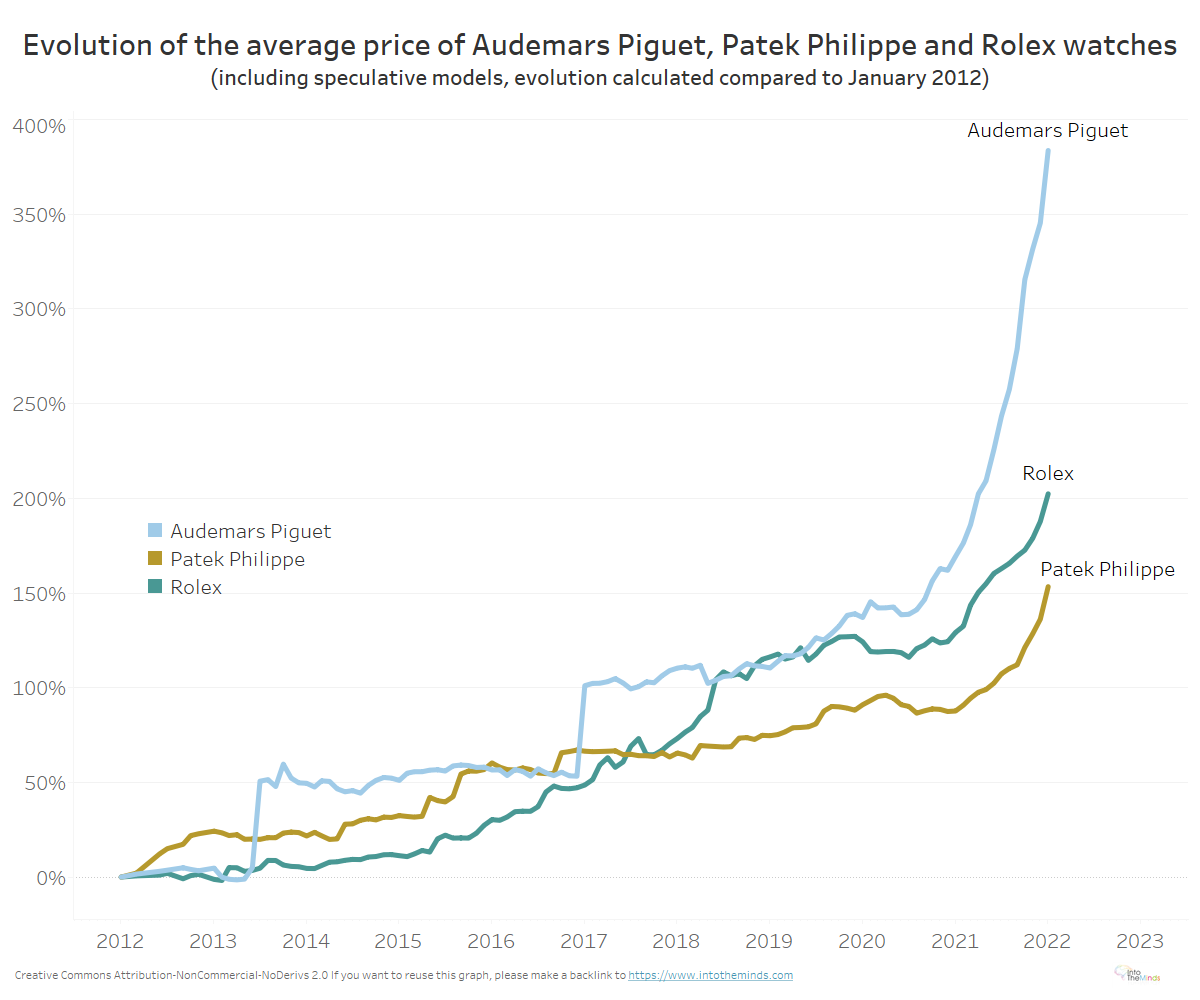
Embed this media on your website
Once the overall strategy is described, you will need to describe the other aspects of the marketing mix that depend on price:
- the pricing policy towards your intermediaries
- the discount policy towards your customers
- the payment policy and possible facilities offered to your customers to acquire your products

The P of “Promotion” (Communication Policy)
The third “P” is “Promotion.” It covers the aspects related to the company’s communication and the strategies used to make itself known on the market. The result is measured by the notoriety of the company among its target customers.
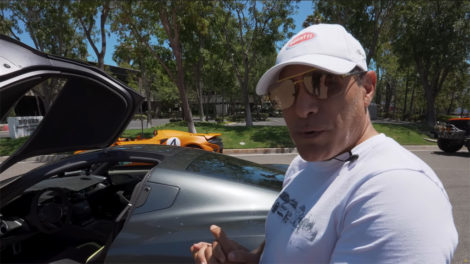
Electric hypercar manufacturer Rimac promotes its Nevera model by using YouTubers. Here Many Koshbin tries the vehicle in one of his YouTube videos (YouTube screenshot)
It is helpful to start by describing, in broad lines, the communication strategy followed by the company. What is the company’s position on advertising, and does it realize using advertising? Are specific media used (sponsoring, influencers, etc.)? If so, which channels are favored (digital, radio, TV, press, Out-Of-Home), and according to what logic are these channels selected?
When advertising investments are made, the repetition of messages plays a role in the persistence of the information in the consumer’s mind. Therefore, the analysis should try to clarify which repetition is aimed at, which will make it possible to deduce the advertising pressure that the company wants to impose and the importance of advertising in its global strategy.
In addition to advertising, the company can also promote itself through inbound marketing . It is, therefore, a matter of attracting prospects naturally. Inbound marketing is a tactic that materializes in the digital space. The goal is to improve natural referencing (SEO) to capture the attention of Internet users and attract them to the company’s website. It is, therefore, necessary to analyze whether the company invests in content marketing and, if so, which online media are privileged.

The P of “Place” (Distribution Policy)
The fourth “P” concerns the distribution policy (“Place” or “Placement” according to the 4P terminology). In this part, we analyze how the product or service is distributed. There are three main distribution strategies:
- direct distribution
- distribution via a third-party network
- hybrid (a mix of the 2 previous ones)
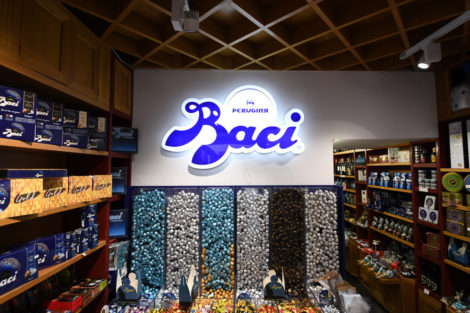
Perugina commercializes its “Baci” in large-scale distribution but also has some stores of its own (here the one in Perugia)
Nespresso distributes its coffee capsules through its own stores (direct distribution). Most food manufacturers sell their products through third-party networks (retailers). However, some of these manufacturers invest in their own stores ( Perugina , Lindt, M&M, ….). This is a hybrid strategy.
Once the broad lines have been drawn, the analysis of the marketing mix requires going into detail. It is advisable to study the opportunity of franchising, especially when the ambitions are high in terms of the geographical distribution of products. Covering a large territory requires significant resources. Therefore, a start-up with a product in high demand may have to turn to the franchise model to accelerate its deployment. This is a widespread model in the fast-food industry.

The Printemps store in Paris offers visibility to many brands and attracts foreign tourists. Crédits : gibs02 via Flickr.
Outsourced distribution (via a franchise network or third-party distributors) also has marketing coverage advantages. Some brands may naturally attract customer segments that could represent additional sales for your company. Regardless of the distribution strategy chosen, careful consideration must be given to the location of sales outlets (in the case of physical sales). The research on implementing physical commerce is of particular importance because of the decline in the number of visitors to physical sales outlets . Over the last 10 years, city centers have lost 50% of their pedestrian traffic, which inevitably affects profitability.
If the company opts for e-commerce (which seems essential), particular attention must be paid to the logistical aspects. In particular, request what logistical processes need to be implemented to meet customer expectations regarding product availability and delivery times. Customer requirements are constantly increasing. They are shaped by the delivery policies of the industry’s giants (Amazon and others), whose logistical excellence allows them to shorten delivery times even further. For SMEs that lack operational excellence, the use of third-party fulfillment services can be an enjoyable (but costly) alternative to compete with the giants.

The P of “People” (Relationship policy)
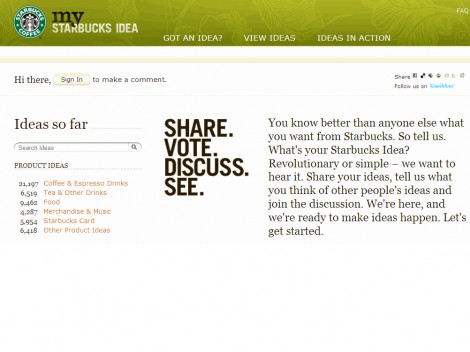
Starbucks had set up a co-creation platform allowing customers to propose ideas to the company. Customer interaction was also possible.
The relational policy (the fifth “P”) is part of the 3 new “Ps” proposed by Booms and Bitner in 1981. The recognition of the role of the human being coincides with the emergence of relational marketing . We understand that the human component can contribute positively to the quality of service and customer satisfaction/loyalty.
In this part of the marketing mix, we will focus on understanding how its marketing positioning can be materialized through its human component. We will study the human part in the success of the company, and the satisfaction of the customer, as well as the role, played by the employees to transmit the values of the brand.
In the digital era, the relational policy is no longer only in B2C. It also materializes through C2C (Consumer To Consumer) interactions. Customers become ambassadors for the company and sometimes even play essential roles. Ryanair, for example, has set up a customer advisory board . Hollister, a medical equipment manufacturer, has created its Vivre+ network to create links between patients through activities organized throughout France. The customer thus becomes an essential component of the marketing strategy. They become a full-fledged player, just like the employee.

The P of “Process” (the processes related to the service)
This part of the marketing mix is about describing and analyzing the processes surrounding the service. To make your analysis enjoyable, you should focus on the most distinctive elements of the processes.

Processes are a central component in the success of Ryanair’s low-cost business model.
In the case of a low-cost airline (see case study), we will look at the role of processes in the business model’s success .
When the marketing positioning is the opposite (luxury), the sales processes play a significant role. The attitude, gestures, and behavior of salespeople are codified to align with the values embodied.
Your marketing mix analysis can quickly skim over certain aspects and should go into detail when justified.

The P of “Physical evidence”

Abercrombie & Fitch used to emphasize the plastic qualities of its salespeople to attract customers.
The last of the 7Ps is called “physical evidence.” In the spirit of the marketing mix, it is the tangible elements with which the customer is in contact when he buys the product .
These elements can be linked to the sales outlet itself (its design, its layout, the sound/smell / visual atmosphere), the objects found there, or the employees themselves (specific clothes, for example). The brand Abercrombie & Fitch , for example, became famous for the olfactory and sound ambiance of its sales outlets. Its employees, chosen for their “visual” qualities, worked shirtless.
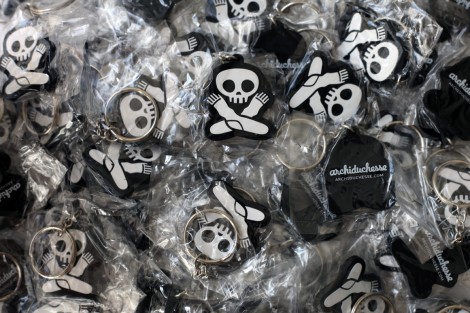
The brand Archiduchesse sends its products accompanied by some “goodies” (candies, stickers, key rings)
If we immediately think of the attributes of the sales outlet, we must not forget the digital space. Online reviews are now part of the “proof” that the customer integrates before making a decision. The delivery can also be an important moment to comfort the customer in his choice. In this article , we have given 3 examples of companies that use delivery as an emotional touchpoint with the customer: the wine estate Le Cazal that adds a sprig of wild thyme to its deliveries, Coolblue that sends a personalized postcard, and Archiduchesse that completes its orders with some “goodies.”
Case study: analysis of Ryanair’s marketing mix
In this research we propose to analyze the marketing mix of Ryanair, the Irish low-cost airline which is today the n°1 airline in Europe .
| Marketing Mix (7Ps) | Analysis |
| “Product” | The “product” proposed is low-cost air travel. The services offered are reduced to a minimum. The additional services (specific seat, catering onboard, …) are all paying to increase the company’s margin. The product’s is remarkable in the sense that the travel conditions are reduced to their simplest expression. On the other hand, Ryanair’s planes connect mostly to secondary airports. are reduced to the legal minimum, and Ryanair has a negative reputation in this area, as it has been called to order several times. Indeed, Ryanair did not apply the for passenger refunds. |
| “Price” | Ryanair’s can be seen as a combination of operational optimization (optimizing aircraft load factors) and revenue optimization (notably through the sale of additional services). Price is a central element of Ryanair’s strategy. The applied is a floor price and the sale of optional services (choice of seats, food, insurance, rental car, luggage, etc.), which increase the final price and the margin. No is proposed, and by credit card is “sanctioned” by an additional premium. The according to that of competitors for similar destinations. Ryanair will always propose a lower departure price. |
| “Promotion” | Ryanair uses multiple communication channels. Their are characterized by often cheeky messages that trigger ethical debates with control panels. The expression “Say good or say bad, but mostly talk about me” seems to be very appropriate. Ryanair also uses more to cultivate its “brand image” and make people talk about it: |
| “Place” | The of Ryanair tickets is entirely focused on e-commerce. Agreements exist with third-party platforms to sell tickets, but these are primarily sold on Ryanair’s website. The is, for the moment, limited to Europe and North Africa. The proposed destinations cover 37 countries and 216 cities. |
| “People” | are the most visible face of the Ryanair brand to customers. Contrary to other airlines, they are for their interpersonal skills. In this sense, they “fit” quite well with the “low-cost” image of the Irish company. If the (often negative) opinions on Ryanair abound on the web, the company does not provide any forum to collect them. Aware of the need to improve its image, the company has recently set up a . This committee will allow a few selected customers to interact and give their opinions on its orientation. |
| “Process” | The process part is essential for Ryanair. Indeed, the company’s success is based mainly on . The company has chosen a single aircraft model to reduce costs. It imposes (boarding, disembarking) on its customers and crews to increase the frequency of aircraft rotation. In doing so, they reduce downtime and improve the profitability of their equipment. |
| “Physical Evidence” | The are Ryanair’s “sales outlet.” This is where the “product” takes shape. The is unique: spartan furnishings, flashy colors, loud announcements… it is the opposite of a traditional airline. The ritual of the little music at landing is immutable to remind the passenger that Ryanair arrives on time. And the passengers love it because they applaud loudly, a custom unthinkable in another airline’s plane. |
Marketing Mix guide (free download)
- Market research methodology
20 February 2022
Amazing stuff. I really found this article very interesting and helpful. The case study at the end of the article really helped to drive home the points raised in each of the elements of the 7 Ps. I say a big thank you to Dr Pierre-Nicolas S. Merci beaucoup.
21 February 2022
You’re welcome. THank you for your kind words. You can find even more here : https://www.intotheminds.com/blog/en/marketing-mix-guide/
Post your opinion
Your email address will not be published. Required fields are marked *
Save my name, email, and website in this browser for the next time I comment.
Don't forget to check your spam folder .
You didn't receive the link?
Pour offrir les meilleures expériences, nous utilisons des technologies telles que les cookies pour stocker et/ou accéder aux informations des appareils. Le fait de consentir à ces technologies nous permettra de traiter des données telles que le comportement de navigation ou les ID uniques sur ce site. Le fait de ne pas consentir ou de retirer son consentement peut avoir un effet négatif sur certaines caractéristiques et fonctions.
28 Case Study Examples Every Marketer Should See
Published: March 08, 2023
Putting together a compelling case study is one of the most powerful strategies for showcasing your product and attracting future customers. But it's not easy to create case studies that your audience can’t wait to read.

In this post, we’ll go over the definition of a case study and the best examples to inspire you.

What is a case study?
A case study is a detailed story of something your company did. It includes a beginning — often discussing a conflict, an explanation of what happened next, and a resolution that explains how the company solved or improved on something.
A case study proves how your product has helped other companies by demonstrating real-life results. Not only that, but marketing case studies with solutions typically contain quotes from the customer. This means that they’re not just ads where you praise your own product. Rather, other companies are praising your company — and there’s no stronger marketing material than a verbal recommendation or testimonial. A great case study is also filled with research and stats to back up points made about a project's results.
There are myriad ways to use case studies in your marketing strategy . From featuring them on your website to including them in a sales presentation, a case study is a strong, persuasive tool that shows customers why they should work with you — straight from another customer. Writing one from scratch is hard, though, which is why we’ve created a collection of case study templates for you to get started.
Fill out the form below to access the free case study templates.

Free Case Study Templates
Showcase your company's success using these three free case study templates.
- Data-Driven Case Study Template
- Product-Specific Case Study Template
- General Case Study Template
Download Free
All fields are required.
You're all set!
Click this link to access this resource at any time.
There’s no better way to generate more leads than by writing case studies . But without case study examples to draw inspiration from, it can be difficult to write impactful studies that convince visitors to submit a form.
Marketing Case Study Examples
To help you create an attractive and high-converting case study, we've put together a list of some of our favorites. This list includes famous case studies in marketing, technology, and business.
These studies can show you how to frame your company offers in a way that is both meaningful and useful to your audience. So, take a look, and let these examples inspire your next brilliant case study design.
These marketing case studies with solutions show the value proposition of each product. They also show how each company benefited in both the short and long term using quantitative data. In other words, you don’t get just nice statements, like "This company helped us a lot." You see actual change within the firm through numbers and figures.
You can put your learnings into action with HubSpot's Free Case Study Templates . Available as custom designs and text-based documents, you can upload these templates to your CMS or send them to prospects as you see fit.

1. " How Handled Scaled from Zero to 121 Locations with the Help of HubSpot ," by HubSpot

What's interesting about this case study is the way it leads with the customer. That reflects a major HubSpot cornerstone, which is to always solve for the customer first. The copy leads with a brief description of why the CEO of Handled founded the company and why he thought Handled could benefit from adopting a CRM. The case study also opens up with one key data point about Handled’s success using HubSpot, namely that it grew to 121 locations.
Notice that this case study uses mixed media. Yes, there is a short video, but it's elaborated upon in the other text on the page. So while your case studies can use one or the other, don't be afraid to combine written copy with visuals to emphasize the project's success.
Key Learnings from the HubSpot Case Study Example
- Give the case study a personal touch by focusing on the CEO rather than the company itself.
- Use multimedia to engage website visitors as they read the case study.
2. " The Whole Package ," by IDEO

Here's a design company that knows how to lead with simplicity in its case studies. As soon as the visitor arrives at the page, they’re greeted with a big, bold photo and the title of the case study — which just so happens to summarize how IDEO helped its client. It summarizes the case study in three snippets: The challenge, the impact, and the outcome.
Immediately, IDEO communicates its impact — the company partnered with H&M to remove plastic from its packaging — but it doesn't stop there. As the user scrolls down, the challenge, impact, and progress are elaborated upon with comprehensive (but not overwhelming) copy that outlines what that process looked like, replete with quotes and intriguing visuals.
Key Learnings from the IDEO Case Study Example
- Split up the takeaways of your case studies into bite-sized sections.
- Always use visuals and images to enrich the case study experience, especially if it’s a comprehensive case study.
3. " Rozum Robotics intensifies its PR game with Awario ," by Awario

In this case study, Awario greets the user with a summary straight away — so if you’re feeling up to reading the entire case study, you can scan the snapshot and understand how the company serves its customers. The case study then includes jump links to several sections, such as "Company Profile," "Rozum Robotics' Pains," "Challenge," "Solution," and "Results and Improvements."
The sparse copy and prominent headings show that you don’t need a lot of elaborate information to show the value of your products and services. Like the other case study examples on this list, it includes visuals and quotes to demonstrate the effectiveness of the company’s efforts. The case study ends with a bulleted list that shows the results.
Key Learnings from the Awario Robotics Case Study Example
- Create a table of contents to make your case study easier to navigate.
- Include a bulleted list of the results you achieved for your client.
4. " Chevrolet DTU ," by Carol H. Williams

If you’ve worked with a company that’s well-known, use only the name in the title — like Carol H. Williams, one of the nation’s top advertising agencies, does here. The "DTU," stands for "Discover the Unexpected." It generates interest because you want to find out what the initials mean.
They keep your interest in this case study by using a mixture of headings, images, and videos to describe the challenges, objectives, and solutions of the project. The case study closes with a summary of the key achievements that Chevrolet’s DTU Journalism Fellows reached during the project.
Key Learnings from the Carol H. Williams Case Study Example
- If you’ve worked with a big brand before, consider only using the name in the title — just enough to pique interest.
- Use a mixture of headings and subheadings to guide users through the case study.
5. " How Fractl Earned Links from 931 Unique Domains for Porch.com in a Single Year ," by Fractl

Fractl uses both text and graphic design in their Porch.com case study to immerse the viewer in a more interesting user experience. For instance, as you scroll, you'll see the results are illustrated in an infographic-design form as well as the text itself.
Further down the page, they use icons like a heart and a circle to illustrate their pitch angles, and graphs to showcase their results. Rather than writing which publications have mentioned Porch.com during Fractl’s campaign, they incorporated the media outlets’ icons for further visual diversity.
Key Learnings from the Fractl Case Study Example
- Let pictures speak for you by incorporating graphs, logos, and icons all throughout the case study.
- Start the case study by right away stating the key results, like Fractl does, instead of putting the results all the way at the bottom.
6. " The Met ," by Fantasy

What's the best way to showcase the responsiveness and user interface of a website? Probably by diving right into it with a series of simple showcases— which is exactly what Fantasy does on their case study page for the Metropolitan Museum of Art. They keep the page simple and clean, inviting you to review their redesign of the Met’s website feature-by-feature.
Each section is simple, showing a single piece of the new website's interface so that users aren’t overwhelmed with information and can focus on what matters most.
If you're more interested in text, you can read the objective for each feature. Fantasy understands that, as a potential customer, this is all you need to know. Scrolling further, you're greeted with a simple "Contact Us" CTA.
Key Learnings from the Fantasy Case Study Example
- You don’t have to write a ton of text to create a great case study. Focus on the solution you delivered itself.
- Include a CTA at the bottom inviting visitors to contact you.
7. " Rovio: How Rovio Grew Into a Gaming Superpower ," by App Annie

If your client had a lot of positive things to say about you, take a note from App Annie’s Rovio case study and open up with a quote from your client. The case study also closes with a quote, so that the case study doesn’t seem like a promotion written by your marketing team but a story that’s taken straight from your client’s mouth. It includes a photo of a Rovio employee, too.
Another thing this example does well? It immediately includes a link to the product that Rovio used (namely, App Annie Intelligence) at the top of the case study. The case study closes with a call-to-action button prompting users to book a demo.
Key Learnings from the App Annie Case Study Example
- Feature quotes from your client at the beginning and end of the case study.
- Include a mention of the product right at the beginning and prompt users to learn more about the product.
8. " Embracing first-party data: 3 success stories from HubSpot ," by Think with Google

Google takes a different approach to text-focused case studies by choosing three different companies to highlight.
The case study is clean and easily scannable. It has sections for each company, with quotes and headers that clarify the way these three distinct stories connect. The simple format also uses colors and text that align with the Google brand.
Another differentiator is the focus on data. This case study is less than a thousand words, but it's packed with useful data points. Data-driven insights quickly and clearly show how the value of leveraging first-party data while prioritizing consumer privacy.

Key Learnings from the Think with Google Case Study Example
- A case study doesn’t need to be long or complex to be powerful.
- Clear data points are a quick and effective way to prove value.
9. " In-Depth Performance Marketing Case Study ," by Switch

Switch is an international marketing agency based in Malta that knocks it out of the park with this case study. Its biggest challenge is effectively communicating what it did for its client without ever revealing the client’s name. It also effectively keeps non-marketers in the loop by including a glossary of terms on page 4.
The PDF case study reads like a compelling research article, including titles like "In-Depth Performance Marketing Case Study," "Scenario," and "Approach," so that readers get a high-level overview of what the client needed and why they approached Switch. It also includes a different page for each strategy. For instance, if you’d only be interested in hiring Switch for optimizing your Facebook ads, you can skip to page 10 to see how they did it.
The PDF is fourteen pages long but features big fonts and plenty of white space, so viewers can easily skim it in only a few minutes.
Key Learnings from the Switch Case Study Example
- If you want to go into specialized information, include a glossary of terms so that non-specialists can easily understand.
- Close with a CTA page in your case study PDF and include contact information for prospective clients.
10. " Gila River ," by OH Partners

Let pictures speak for you, like OH Partners did in this case study. While you’ll quickly come across a heading and some text when you land on this case study page, you’ll get the bulk of the case study through examples of actual work OH Partners did for its client. You will see OH Partners’ work in a billboard, magazine, and video. This communicates to website visitors that if they work with OH Partners, their business will be visible everywhere.
And like the other case studies here, it closes with a summary of what the firm achieved for its client in an eye-catching way.
Key Learnings from the OH Partners Case Study Example
- Let the visuals speak by including examples of the actual work you did for your client — which is especially useful for branding and marketing agencies.
- Always close out with your achievements and how they impacted your client.
11. " Facing a Hater ," by Digitas

Digitas' case study page for Sprite’s #ILOVEYOUHATER campaign keeps it brief while communicating the key facts of Digitas’ work for the popular soda brand. The page opens with an impactful image of a hundred people facing a single man. It turns out, that man is the biggest "bully" in Argentina, and the people facing him are those whom he’s bullied before.
Scrolling down, it's obvious that Digitas kept Sprite at the forefront of their strategy, but more than that, they used real people as their focal point. They leveraged the Twitter API to pull data from Tweets that people had actually tweeted to find the identity of the biggest "hater" in the country. That turned out to be @AguanteElCofler, a Twitter user who has since been suspended.
Key Learnings from the Digitas Case Study Example
- If a video was part of your work for your client, be sure to include the most impactful screenshot as the heading.
- Don’t be afraid to provide details on how you helped your client achieve their goals, including the tools you leveraged.
12. " Better Experiences for All ," by HermanMiller

HermanMiller sells sleek, utilitarian furniture with no frills and extreme functionality, and that ethos extends to its case study page for a hospital in Dubai.
What first attracted me to this case study was the beautiful video at the top and the clean user experience. User experience matters a lot in a case study. It determines whether users will keep reading or leave. Another notable aspect of this case study is that the video includes closed-captioning for greater accessibility, and users have the option of expanding the CC and searching through the text.
HermanMiller’s case study also offers an impressive amount of information packed in just a few short paragraphs for those wanting to understand the nuances of their strategy. It closes out with a quote from their client and, most importantly, the list of furniture products that the hospital purchased from the brand.
Key Learnings from the HermanMiller Case Study Example
- Close out with a list of products that users can buy after reading the case study.
- Include accessibility features such as closed captioning and night mode to make your case study more user-friendly.
13. " Capital One on AWS ," by Amazon

Do you work continuously with your clients? Consider structuring your case study page like Amazon did in this stellar case study example. Instead of just featuring one article about Capital One and how it benefited from using AWS, Amazon features a series of articles that you can then access if you’re interested in reading more. It goes all the way back to 2016, all with different stories that feature Capital One’s achievements using AWS.
This may look unattainable for a small firm, but you don’t have to go to extreme measures and do it for every single one of your clients. You could choose the one you most wish to focus on and establish a contact both on your side and your client’s for coming up with the content. Check in every year and write a new piece. These don’t have to be long, either — five hundred to eight hundred words will do.
Key Learnings from the Amazon AWS Case Study Example
- Write a new article each year featuring one of your clients, then include links to those articles in one big case study page.
- Consider including external articles as well that emphasize your client’s success in their industry.
14. " HackReactor teaches the world to code #withAsana ," by Asana

While Asana's case study design looks text-heavy, there's a good reason. It reads like a creative story, told entirely from the customer's perspective.
For instance, Asana knows you won't trust its word alone on why this product is useful. So, they let Tony Phillips, HackReactor CEO, tell you instead: "We take in a lot of information. Our brains are awful at storage but very good at thinking; you really start to want some third party to store your information so you can do something with it."
Asana features frequent quotes from Phillips to break up the wall of text and humanize the case study. It reads like an in-depth interview and captivates the reader through creative storytelling. Even more, Asana includes in-depth detail about how HackReactor uses Asana. This includes how they build templates and workflows:
"There's a huge differentiator between Asana and other tools, and that’s the very easy API access. Even if Asana isn’t the perfect fit for a workflow, someone like me— a relatively mediocre software engineer—can add functionality via the API to build a custom solution that helps a team get more done."
Key Learnings from the Asana Example
- Include quotes from your client throughout the case study.
- Provide extensive detail on how your client worked with you or used your product.
15. " Rips Sewed, Brand Love Reaped ," by Amp Agency

Amp Agency's Patagonia marketing strategy aimed to appeal to a new audience through guerrilla marketing efforts and a coast-to-coast road trip. Their case study page effectively conveys a voyager theme, complete with real photos of Patagonia customers from across the U.S., and a map of the expedition. I liked Amp Agency's storytelling approach best. It captures viewers' attention from start to finish simply because it's an intriguing and unique approach to marketing.
Key Learnings from the Amp Agency Example
- Open up with a summary that communicates who your client is and why they reached out to you.
- Like in the other case study examples, you’ll want to close out with a quantitative list of your achievements.
16. " NetApp ," by Evisort

Evisort opens up its NetApp case study with an at-a-glance overview of the client. It’s imperative to always focus on the client in your case study — not on your amazing product and equally amazing team. By opening up with a snapshot of the client’s company, Evisort places the focus on the client.
This case study example checks all the boxes for a great case study that’s informative, thorough, and compelling. It includes quotes from the client and details about the challenges NetApp faced during the COVID pandemic. It closes out with a quote from the client and with a link to download the case study in PDF format, which is incredibly important if you want your case study to be accessible in a wider variety of formats.
Key Learnings from the Evisort Example
- Place the focus immediately on your client by including a snapshot of their company.
- Mention challenging eras, such as a pandemic or recession, to show how your company can help your client succeed even during difficult times.
17. " Copernicus Land Monitoring – CLC+ Core ," by Cloudflight

Including highly specialized information in your case study is an effective way to show prospects that you’re not just trying to get their business. You’re deep within their industry, too, and willing to learn everything you need to learn to create a solution that works specifically for them.
Cloudflight does a splendid job at that in its Copernicus Land Monitoring case study. While the information may be difficult to read at first glance, it will capture the interest of prospects who are in the environmental industry. It thus shows Cloudflight’s value as a partner much more effectively than a general case study would.
The page is comprehensive and ends with a compelling call-to-action — "Looking for a solution that automates, and enhances your Big Data system? Are you struggling with large datasets and accessibility? We would be happy to advise and support you!" The clean, whitespace-heavy page is an effective example of using a case study to capture future leads.
Key Learnings from the Cloudflight Case Study Example
- Don’t be afraid to get technical in your explanation of what you did for your client.
- Include a snapshot of the sales representative prospects should contact, especially if you have different sales reps for different industries, like Cloudflight does.
18. " Valvoline Increases Coupon Send Rate by 76% with Textel’s MMS Picture Texting ," by Textel

If you’re targeting large enterprises with a long purchasing cycle, you’ll want to include a wealth of information in an easily transferable format. That’s what Textel does here in its PDF case study for Valvoline. It greets the user with an eye-catching headline that shows the value of using Textel. Valvoline saw a significant return on investment from using the platform.
Another smart decision in this case study is highlighting the client’s quote by putting it in green font and doing the same thing for the client’s results because it helps the reader quickly connect the two pieces of information. If you’re in a hurry, you can also take a look at the "At a Glance" column to get the key facts of the case study, starting with information about Valvoline.
Key Learnings from the Textel Case Study Example
- Include your client’s ROI right in the title of the case study.
- Add an "At a Glance" column to your case study PDF to make it easy to get insights without needing to read all the text.
19. " Hunt Club and Happeo — a tech-enabled love story ," by Happeo

In this blog-post-like case study, Happeo opens with a quote from the client, then dives into a compelling heading: "Technology at the forefront of Hunt Club's strategy." Say you’re investigating Happeo as a solution and consider your firm to be technology-driven. This approach would spark your curiosity about why the client chose to work with Happeo. It also effectively communicates the software’s value proposition without sounding like it’s coming from an in-house marketing team.
Every paragraph is a quote written from the customer’s perspective. Later down the page, the case study also dives into "the features that changed the game for Hunt Club," giving Happeo a chance to highlight some of the platform’s most salient features.
Key Learnings from the Happeo Case Study Example
- Consider writing the entirety of the case study from the perspective of the customer.
- Include a list of the features that convinced your client to go with you.
20. " Red Sox Season Campaign ," by CTP Boston

What's great about CTP's case study page for their Red Sox Season Campaign is their combination of video, images, and text. A video automatically begins playing when you visit the page, and as you scroll, you'll see more embedded videos of Red Sox players, a compilation of print ads, and social media images you can click to enlarge.
At the bottom, it says "Find out how we can do something similar for your brand." The page is clean, cohesive, and aesthetically pleasing. It invites viewers to appreciate the well-roundedness of CTP's campaign for Boston's beloved baseball team.
Key Learnings from the CTP Case Study Example
- Include a video in the heading of the case study.
- Close with a call-to-action that makes leads want to turn into prospects.
21. " Acoustic ," by Genuine

Sometimes, simple is key. Genuine's case study for Acoustic is straightforward and minimal, with just a few short paragraphs, including "Reimagining the B2B website experience," "Speaking to marketers 1:1," and "Inventing Together." After the core of the case study, we then see a quote from Acoustic’s CMO and the results Genuine achieved for the company.
The simplicity of the page allows the reader to focus on both the visual aspects and the copy. The page displays Genuine's brand personality while offering the viewer all the necessary information they need.
- You don’t need to write a lot to create a great case study. Keep it simple.
- Always include quantifiable data to illustrate the results you achieved for your client.
22. " Using Apptio Targetprocess Automated Rules in Wargaming ," by Apptio

Apptio’s case study for Wargaming summarizes three key pieces of information right at the beginning: The goals, the obstacles, and the results.
Readers then have the opportunity to continue reading — or they can walk away right then with the information they need. This case study also excels in keeping the human interest factor by formatting the information like an interview.
The piece is well-organized and uses compelling headers to keep the reader engaged. Despite its length, Apptio's case study is appealing enough to keep the viewer's attention. Every Apptio case study ends with a "recommendation for other companies" section, where the client can give advice for other companies that are looking for a similar solution but aren’t sure how to get started.
Key Learnings from the Apptio Case Study Example
- Put your client in an advisory role by giving them the opportunity to give recommendations to other companies that are reading the case study.
- Include the takeaways from the case study right at the beginning so prospects quickly get what they need.
23. " Airbnb + Zendesk: building a powerful solution together ," by Zendesk

Zendesk's Airbnb case study reads like a blog post, and focuses equally on Zendesk and Airbnb, highlighting a true partnership between the companies. To captivate readers, it begins like this: "Halfway around the globe is a place to stay with your name on it. At least for a weekend."
The piece focuses on telling a good story and provides photographs of beautiful Airbnb locations. In a case study meant to highlight Zendesk's helpfulness, nothing could be more authentic than their decision to focus on Airbnb's service in such great detail.
Key Learnings from the Zendesk Case Study Example
- Include images of your client’s offerings — not necessarily of the service or product you provided. Notice how Zendesk doesn’t include screenshots of its product.
- Include a call-to-action right at the beginning of the case study. Zendesk gives you two options: to find a solution or start a trial.
24. " Biobot Customer Success Story: Rollins College, Winter Park, Florida ," by Biobot

Like some of the other top examples in this list, Biobot opens its case study with a quote from its client, which captures the value proposition of working with Biobot. It mentions the COVID pandemic and goes into detail about the challenges the client faced during this time.
This case study is structured more like a news article than a traditional case study. This format can work in more formal industries where decision-makers need to see in-depth information about the case. Be sure to test different methods and measure engagement .
Key Learnings from the Biobot Case Study Example
- Mention environmental, public health, or economic emergencies and how you helped your client get past such difficult times.
- Feel free to write the case study like a normal blog post, but be sure to test different methods to find the one that best works for you.
25. " Discovering Cost Savings With Efficient Decision Making ," by Gartner

You don't always need a ton of text or a video to convey your message — sometimes, you just need a few paragraphs and bullet points. Gartner does a fantastic job of quickly providing the fundamental statistics a potential customer would need to know, without boggling down their readers with dense paragraphs. The case study closes with a shaded box that summarizes the impact that Gartner had on its client. It includes a quote and a call-to-action to "Learn More."
Key Learnings from the Gartner Case Study Example
- Feel free to keep the case study short.
- Include a call-to-action at the bottom that takes the reader to a page that most relates to them.
26. " Bringing an Operator to the Game ," by Redapt

This case study example by Redapt is another great demonstration of the power of summarizing your case study’s takeaways right at the start of the study. Redapt includes three easy-to-scan columns: "The problem," "the solution," and "the outcome." But its most notable feature is a section titled "Moment of clarity," which shows why this particular project was difficult or challenging.
The section is shaded in green, making it impossible to miss. Redapt does the same thing for each case study. In the same way, you should highlight the "turning point" for both you and your client when you were working toward a solution.
Key Learnings from the Redapt Case Study Example
- Highlight the turning point for both you and your client during the solution-seeking process.
- Use the same structure (including the same headings) for your case studies to make them easy to scan and read.
27. " Virtual Call Center Sees 300% Boost In Contact Rate ," by Convoso

Convoso’s PDF case study for Digital Market Media immediately mentions the results that the client achieved and takes advantage of white space. On the second page, the case study presents more influential results. It’s colorful and engaging and closes with a spread that prompts readers to request a demo.
Key Learnings from the Convoso Case Study Example
- List the results of your work right at the beginning of the case study.
- Use color to differentiate your case study from others. Convoso’s example is one of the most colorful ones on this list.
28. " Ensuring quality of service during a pandemic ," by Ericsson

Ericsson’s case study page for Orange Spain is an excellent example of using diverse written and visual media — such as videos, graphs, and quotes — to showcase the success a client experienced. Throughout the case study, Ericsson provides links to product and service pages users might find relevant as they’re reading the study.
For instance, under the heading "Preloaded with the power of automation," Ericsson mentions its Ericsson Operations Engine product, then links to that product page. It closes the case study with a link to another product page.
Key Learnings from the Ericsson Case Study Example
- Link to product pages throughout the case study so that readers can learn more about the solution you offer.
- Use multimedia to engage users as they read the case study.
Start creating your case study.
Now that you've got a great list of examples of case studies, think about a topic you'd like to write about that highlights your company or work you did with a customer.
A customer’s success story is the most persuasive marketing material you could ever create. With a strong portfolio of case studies, you can ensure prospects know why they should give you their business.
Editor's note: This post was originally published in August 2018 and has been updated for comprehensiveness.

Don't forget to share this post!
Related articles.
![marketing mix case study 7 Pieces of Content Your Audience Really Wants to See [New Data]](https://knowledge.hubspot.com/hubfs/contenttypes.webp)
7 Pieces of Content Your Audience Really Wants to See [New Data]

How to Write a Case Study: Bookmarkable Guide & Template

How to Market an Ebook: 21 Ways to Promote Your Content Offers
![marketing mix case study How to Write a Listicle [+ Examples and Ideas]](https://www.hubspot.com/hubfs/listicle-1.jpg)
How to Write a Listicle [+ Examples and Ideas]
![marketing mix case study What Is a White Paper? [FAQs]](https://53.fs1.hubspotusercontent-na1.net/hubfs/53/business%20whitepaper.jpg)
What Is a White Paper? [FAQs]

What is an Advertorial? 8 Examples to Help You Write One


How to Create Marketing Offers That Don't Fall Flat

20 Creative Ways To Repurpose Content

16 Important Ways to Use Case Studies in Your Marketing

11 Ways to Make Your Blog Post Interactive
Showcase your company's success using these free case study templates.
Marketing software that helps you drive revenue, save time and resources, and measure and optimize your investments — all on one easy-to-use platform
10 Marketing Case Study Examples: Learn How to Master Them in Your Campaigns
There are millions of blog posts, articles, and videos across the internet that try to give you advice about marketing. According to Google, at least 7,050,000 unique content pieces include the phrase “marketing tips.”
But with plenty of outdated and filler content creation to just build out a website, it’s hard to find applicable advice that actually works online.
In this article, you’ll learn from marketing case study examples that demonstrate what it takes to master channels like social media, email marketing , and PPC, as well as how to use case studies in your own campaigns.
Don’t rely on empty words. Learn powerful marketing best practices that are backed up with examples and data.
What is a marketing case study?
In marketing, a case study is an in-depth study of the effectiveness of a certain tool, tactic, or strategy. It focuses on measurable outcomes, like an increase in sales, visitors, or production hours.
Typically, it includes a few key elements:
- Introduction to the customer/client
- The problem the client needed to solve (should align with problems prospective clients also need to solve)
- The solution (and context of why your company/software was the right fit)
- Data from before and after implementing the solution
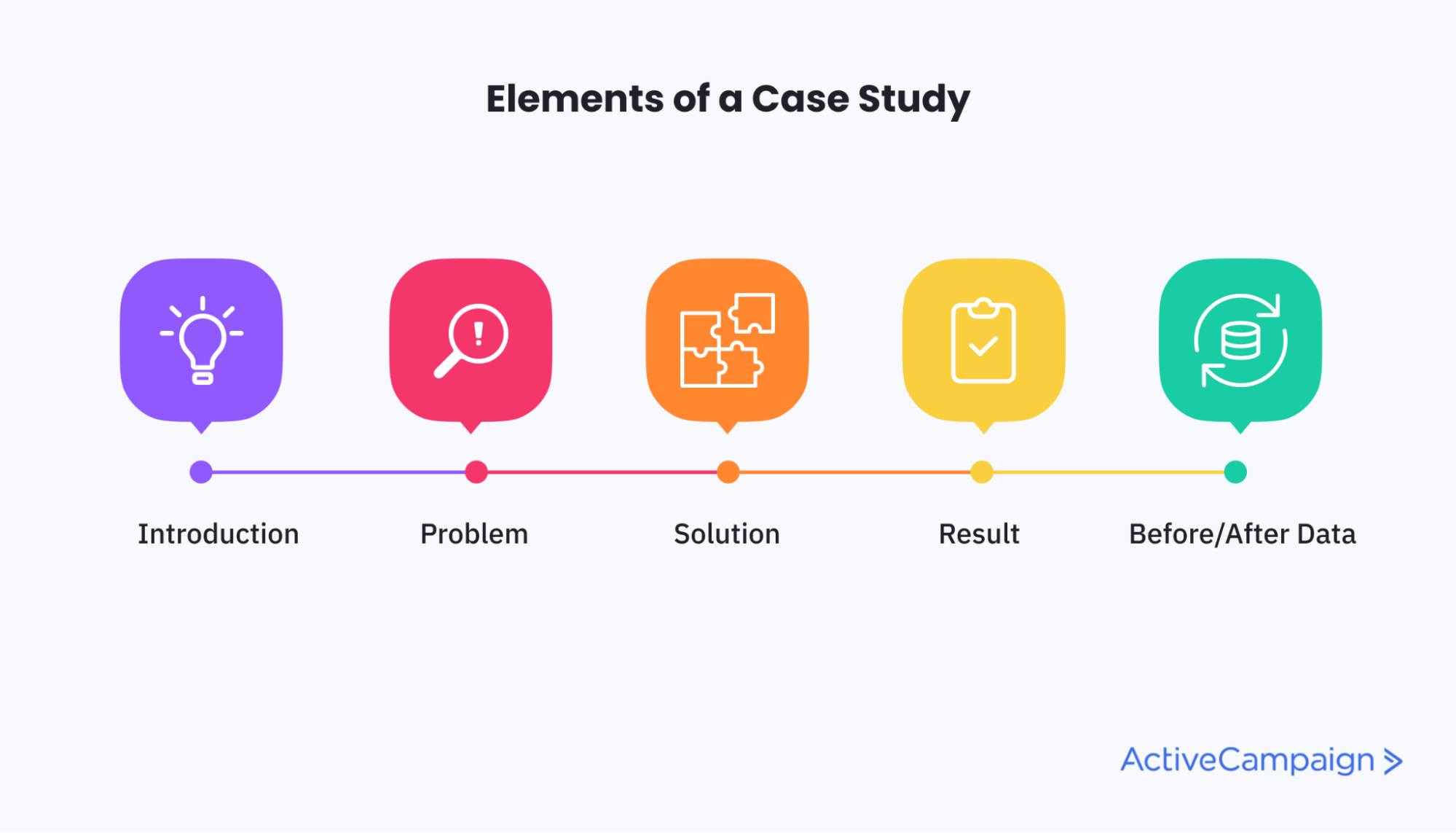
In a sense, a case study documents the journey of working with your company. And it gives potential future customers a reason to trust your company.
What are the different types of case studies in marketing?
In marketing, there are three main types of case studies that are commonly used:
1. Third-person or client case studies: These highlight the experience of a specific client working with your company or using your product.
2. Explanatory case studies: These case studies explore the impact of a phenomenon or tactic, such as the company’s marketing strategy, and how it impacted their growth. In this case, it’s not based on first-hand experience, but rather observation and inference.
3. Implementation case studies: An implementation case study takes the average client case study a bit further, focusing on the actual implementation and covering it in detail.
You can also divide the case studies further by the type of medium they use — video or text.
And in 2021, video case studies are becoming more and more popular. Many companies even use them as remarketing ads to address potential objections.
Why should you use case studies?
Case studies are a powerful way to prove that your products or services work, showcase your expertise, and build trust with potential customers.
It’s a way to transition away from just “telling” your customer and instead start “showing” them through examples. There’s a reason the old copywriting maxim goes, “Show, don’t tell.”
Consumers’ trust in companies to tell the truth in advertising materials is lower than ever. In 2020, only 14% of consumers said they trust advertising to be honest about a product or service.
But that doesn’t mean you can’t generate trust with your company’s website.
Consumers trust third-party reviews, testimonials, and data. In fact, 91% of 18–34-year-olds trust online reviews as much as personal recommendations.
So you need social proof. And client case studies — especially those that interview the current clients — are the best of both worlds. You get to highlight data while getting powerful social proof that shows that your product works.
When just adding a simple customer testimonial to your website can increase conversion rates by up to 34% , imagine what a detailed, compelling case study can do.
1. Email marketing case study: Your Therapy Source
If you think that email is a medium of the past, think again. At ActiveCampaign, we have hundreds of recent case studies that prove the opposite.
For example, Your Therapy Source receives a 2000% return on investment (ROI) from our campaigns simply by taking advantage of basic marketing automation .
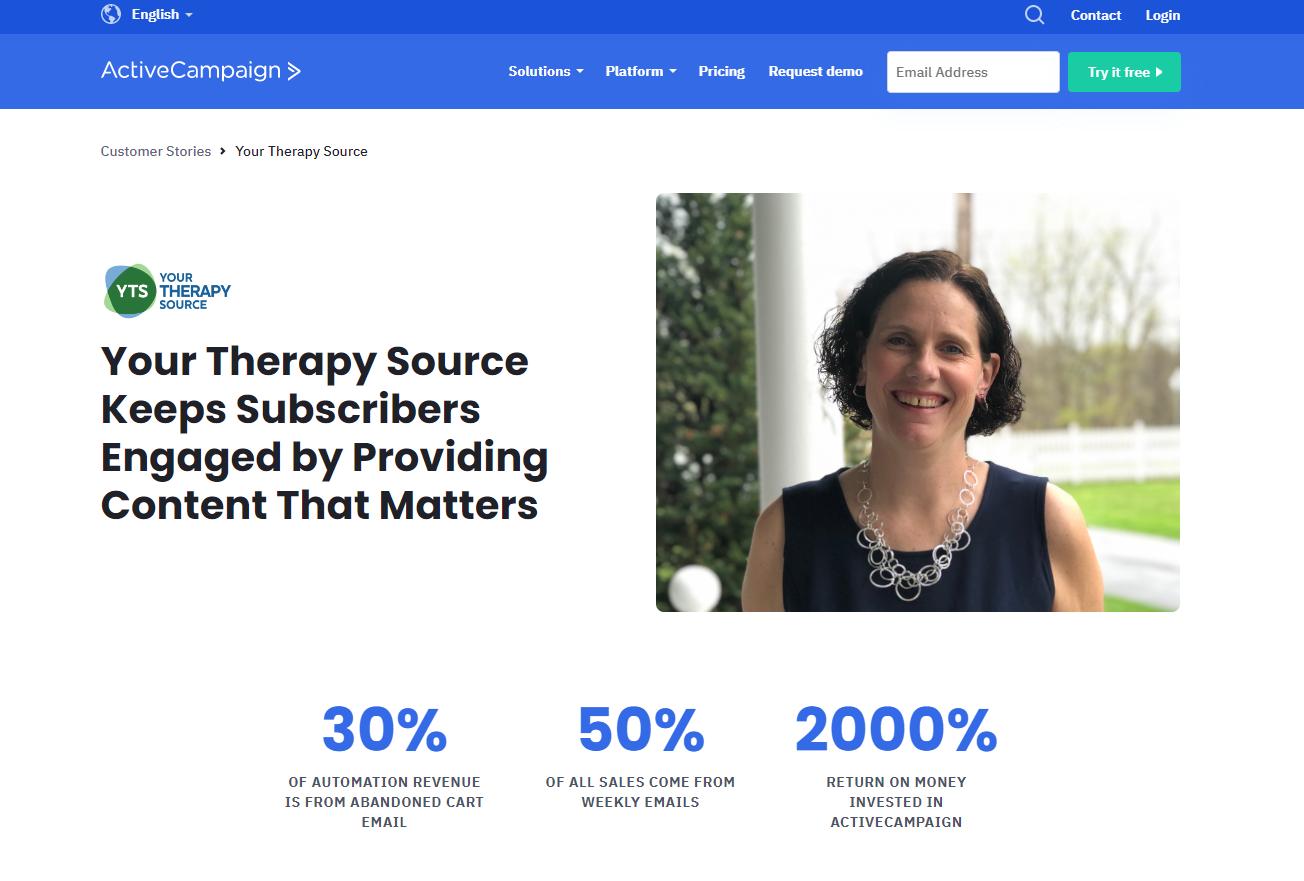
In particular, a basic abandoned cart email represents around 30% of all revenue generated by automations.
With ActiveCampaign, that’s incredibly easy to set up. You can take advantage of our integrations with key e-commerce platforms like WooCommerce , Shopify , and more.
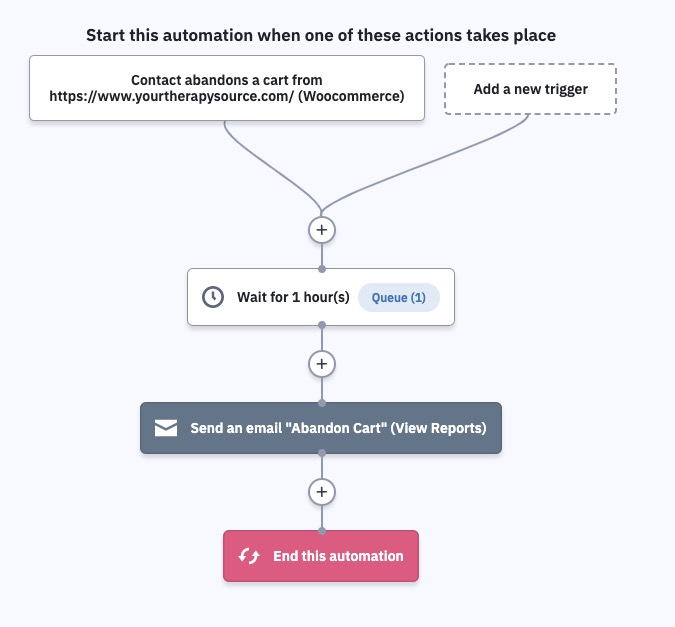
Because the case study goes into detail about exactly how the company achieved the results, it’s a combination of an implementation case study and a regular third-person case study.
2. Instagram marketing case study: Converse
If you look at all the top Instagram accounts in clothing, Converse has a much higher engagement rate than its competitors.
At 1.79%, their social media posts have an organic engagement rate over 15 times higher than Nike.
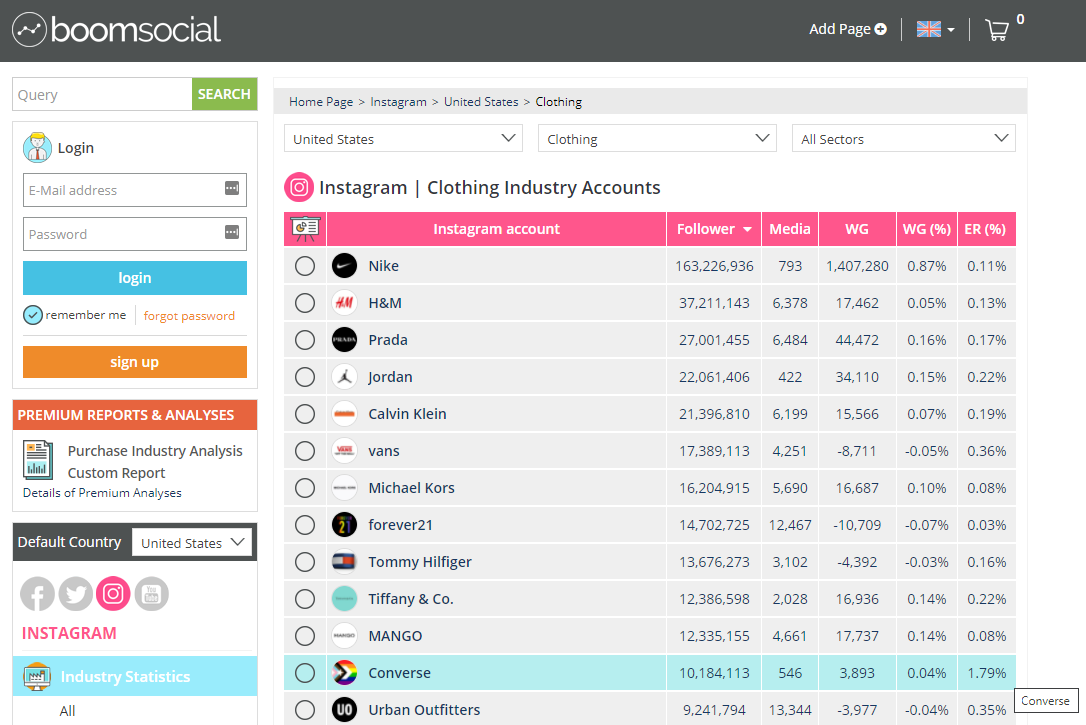
Why is that?
Let’s take a closer look at how they achieve these numbers:
When looking at Converse’s top Instagram posts, you quickly notice a trend. Collaborations with influential creators and artists — lately Tyler, the Creator — get a different level of engagement.
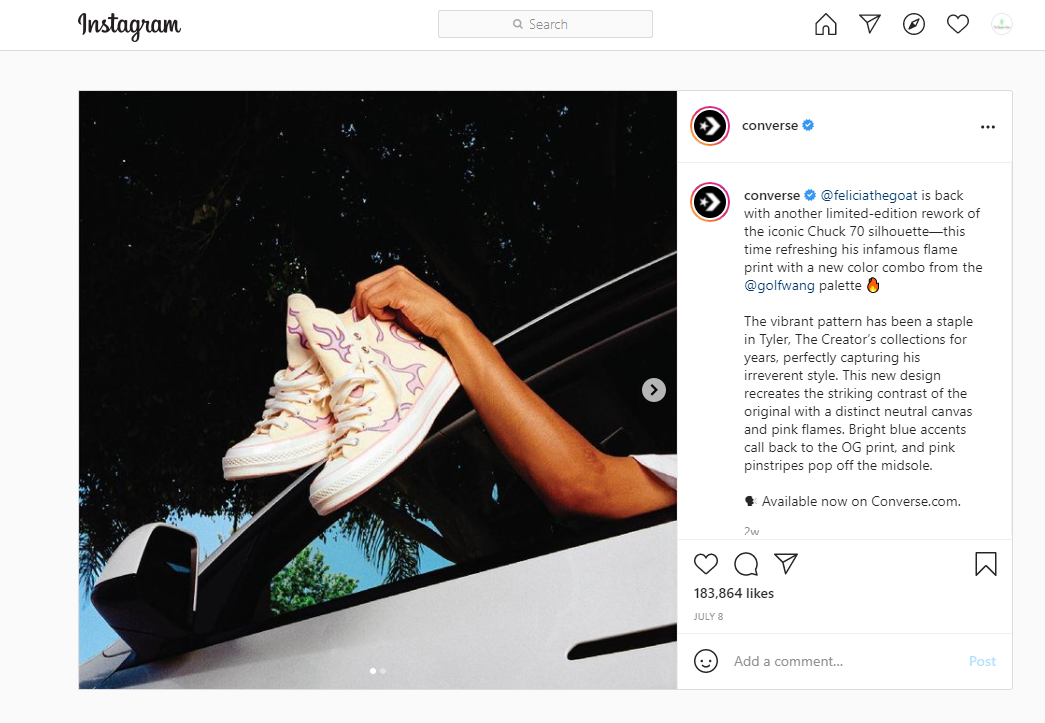
The post promoting their new collaboration shoe got over 183,000 likes in a few weeks. Converse even took it a step further and produced a short film with Tyler.
If you want to reach a wider number of people, combining audiences is a great strategy.
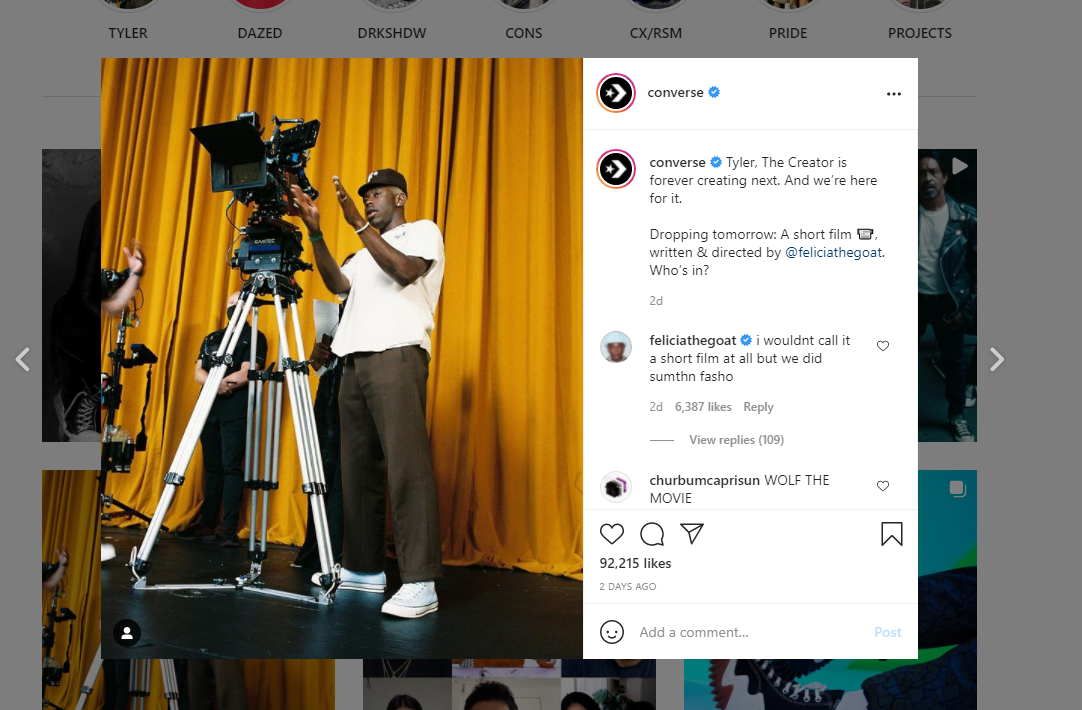
This is an example of an explanatory case study.
First, we worked backward from Converse’s powerful Instagram results. Then, we identified tactics that contribute to their high levels of engagement.
Because we didn’t work directly with Converse, and we’re only observing as an outsider, this is an explanatory case study.
3. Content marketing case study: porch.com
Fractl is a content marketing agency that worked with porch.com for over a year to earn 931 unique domain links, 23,000 monthly organic visits, and more.
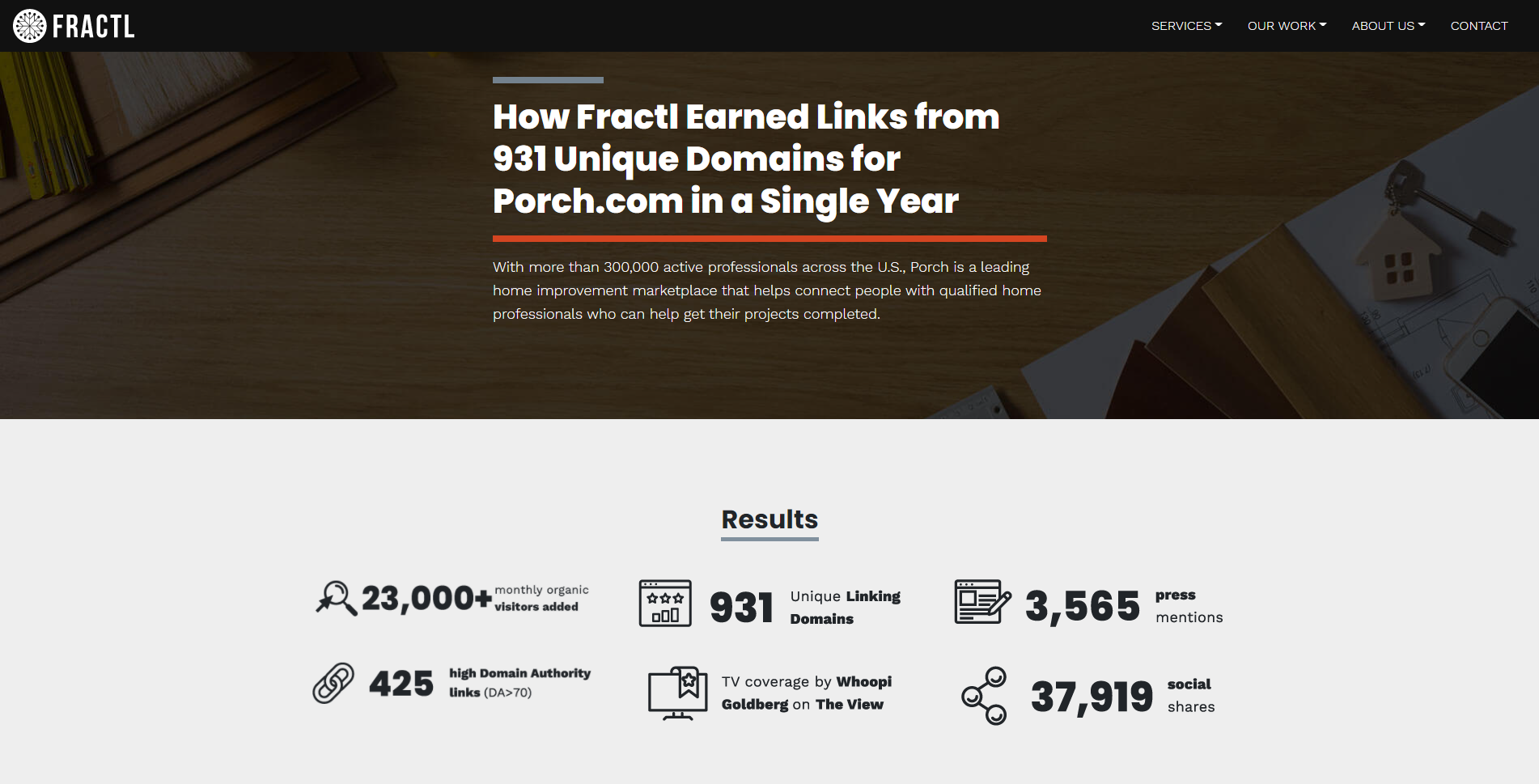
The case study focuses on results over method — that means it’s a typical third-person case study.
They’re showcasing the results the company generated for a specific outside client without getting into the how-to.
These types of case studies are most useful for persuading hesitant potential customers to get on board. Showing that you’ve generated results for similar companies or people in the past is the best way to prove your skill set.
Depending on your target audience, going into detail with an implementation case study may be a better option.
4. SEO case study: Zapier study by Ryan Berg
This in-depth case study by Ryan Berg is a perfect example of how you can use explanatory case studies in your marketing.
It breaks down Zapier’s SEO strategy and how they created over 25,000 unique landing pages to improve their search rankings for different search terms.
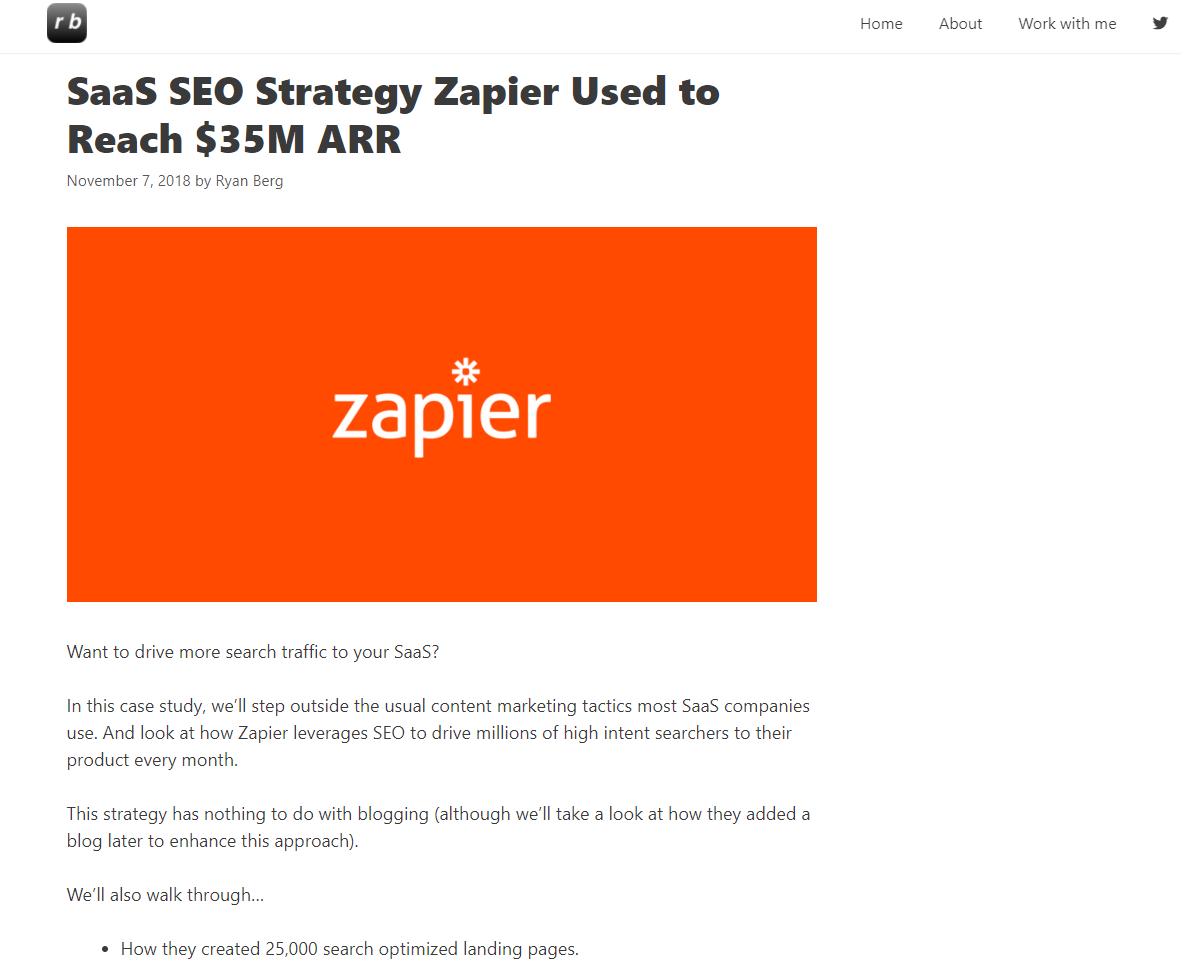
Zapier’s main strategy revolves around targeting relevant long-tail keywords like “app A + app B integration.” That’s the key they used to generate serious organic traffic over the long term.
By breaking down industry leaders and how they rose to success, you can borrow some of their brand power and credibility.
You can use these kinds of case studies if your current clients don’t allow you to go into detail about the tactics you use to grow their online presence.
These case studies demonstrate to potential clients that you know what you’re talking about and have the expertise needed to help them succeed in their industry.
5. PPC case study: Google Ads and Saraf Furniture
When it comes to pay-per-click (PPC) advertising, Google was one of the earliest innovators. And in 2021, it’s still the largest digital advertiser globally, with $146.92 billion in ad revenue in 2020.
You might not think they need any more credibility, but Google still uses case studies, especially in emerging markets like India.
This case study shows how Google Ads helped Saraf Furniture generate 10 times more inbound leads each month and hire 1,500 new carpenters as a result.
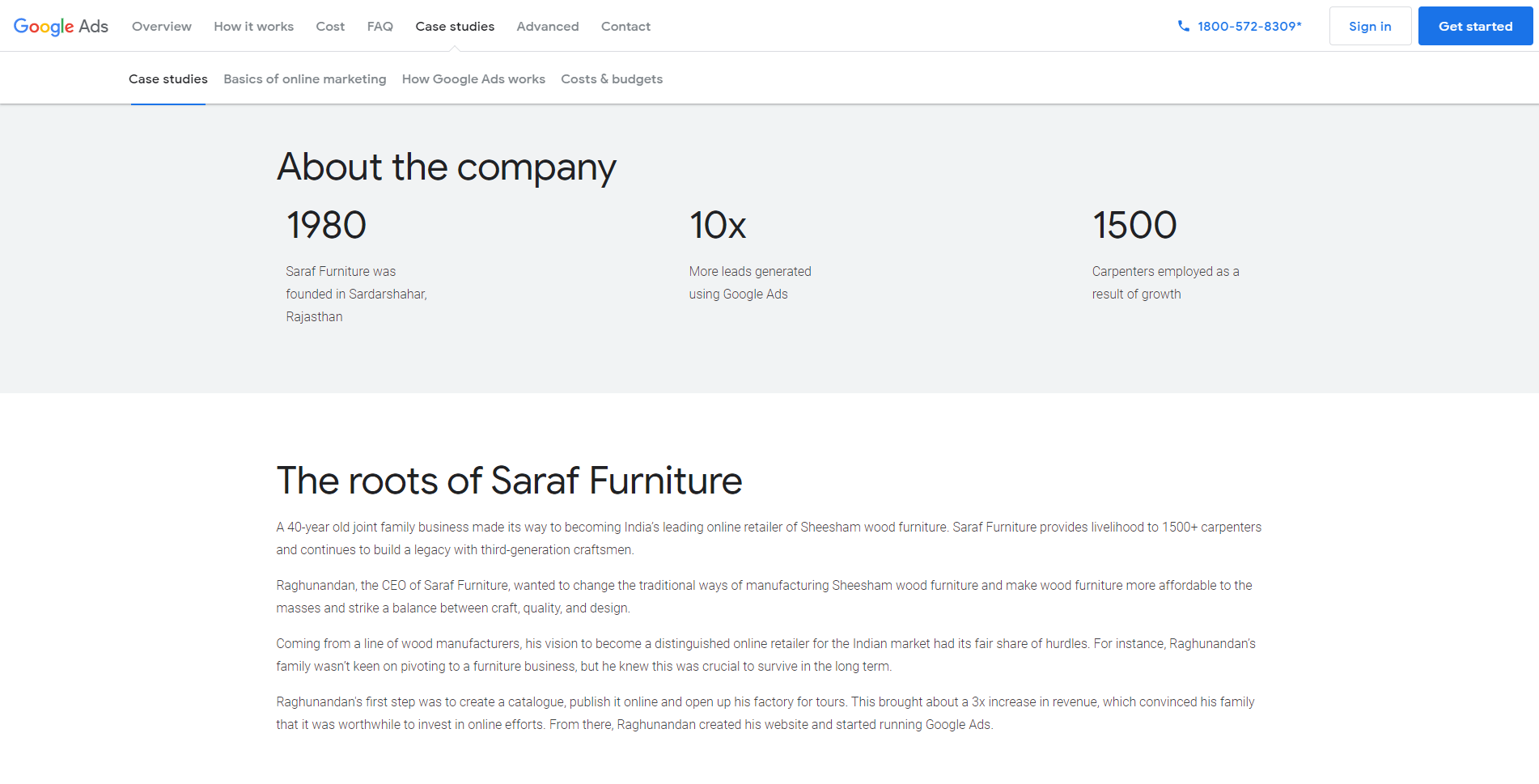
Without going into details about the methods, it’s another typical third-person case study designed to build trust.
6. Video marketing case study: L’Oréal and YouTube
In this case study, various members of L’Oréal’s global marketing team break down exactly how they used YouTube ads to launch a new product.
As a result of the campaign, they were able to establish their new product as the No. 2 in its category and earn 34% of all mass sales across a network of online retailers.
The case study breaks down how they used YouTube for different stages — from awareness to loyalty. It’s another example of a third-person implementation case study.
7. Remarketing case study: AdRoll and Yoga Democracy
AdRoll is a remarketing platform that tracks your visitors and lets you show them targeted ads across the internet.
Their case study with Yoga Democracy perfectly showcases the power of the platform.
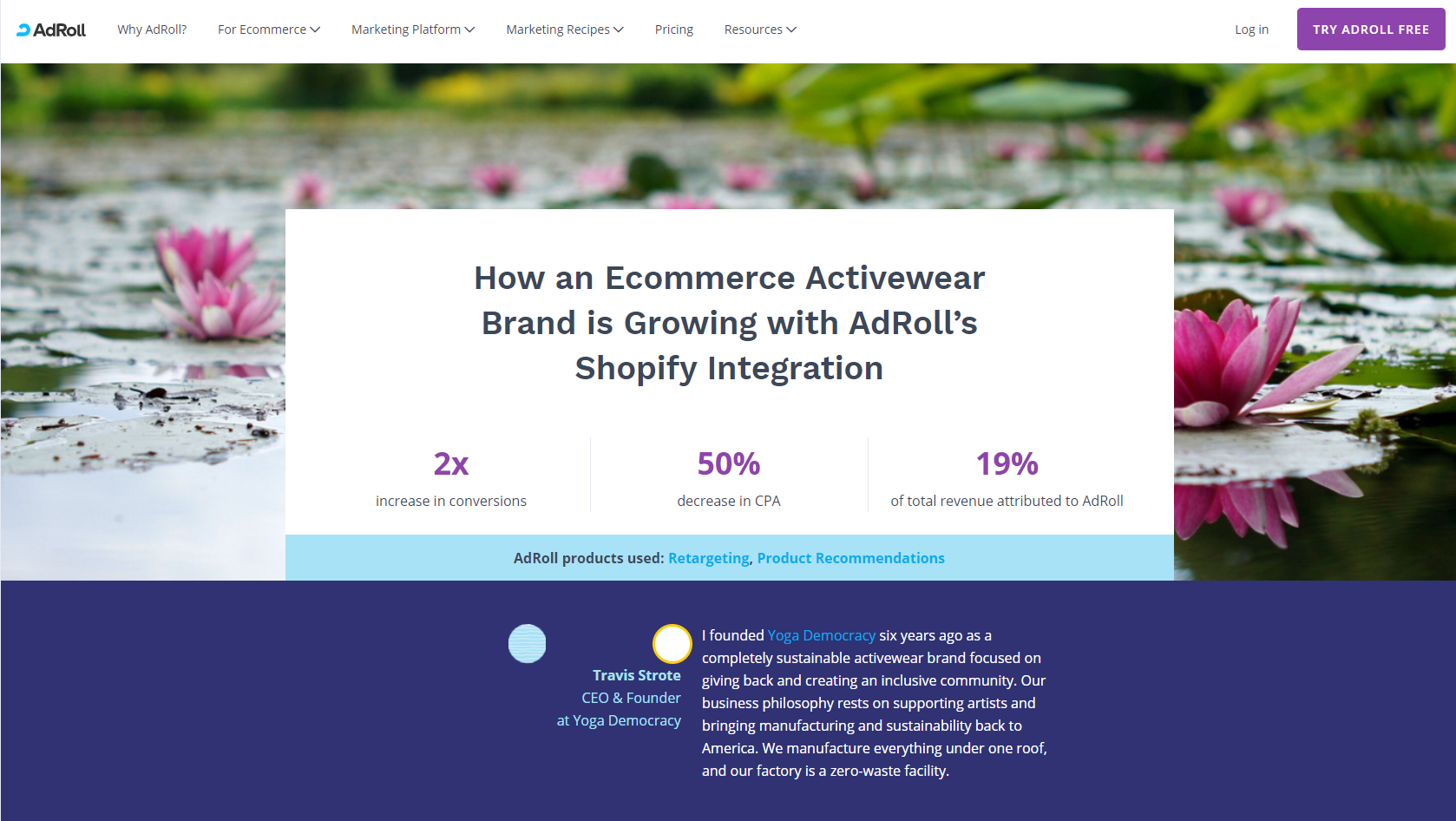
Look at these highlights:
- 200% increase in conversions
- 50% reduction in CPA
- 19% of total revenue attributed to AdRoll
These are metrics you’d love to show any potential customer. The case study goes into detail about how they built an effective remarketing campaign, including cart recovery emails and ads.
Because of the detail, you can classify this as an implementation case study.
8. Influencer marketing case study: Trend and WarbyParker
This influencer marketing case study from Warby Parker and Trend showcases how you can use influencer marketing even with a limited budget.
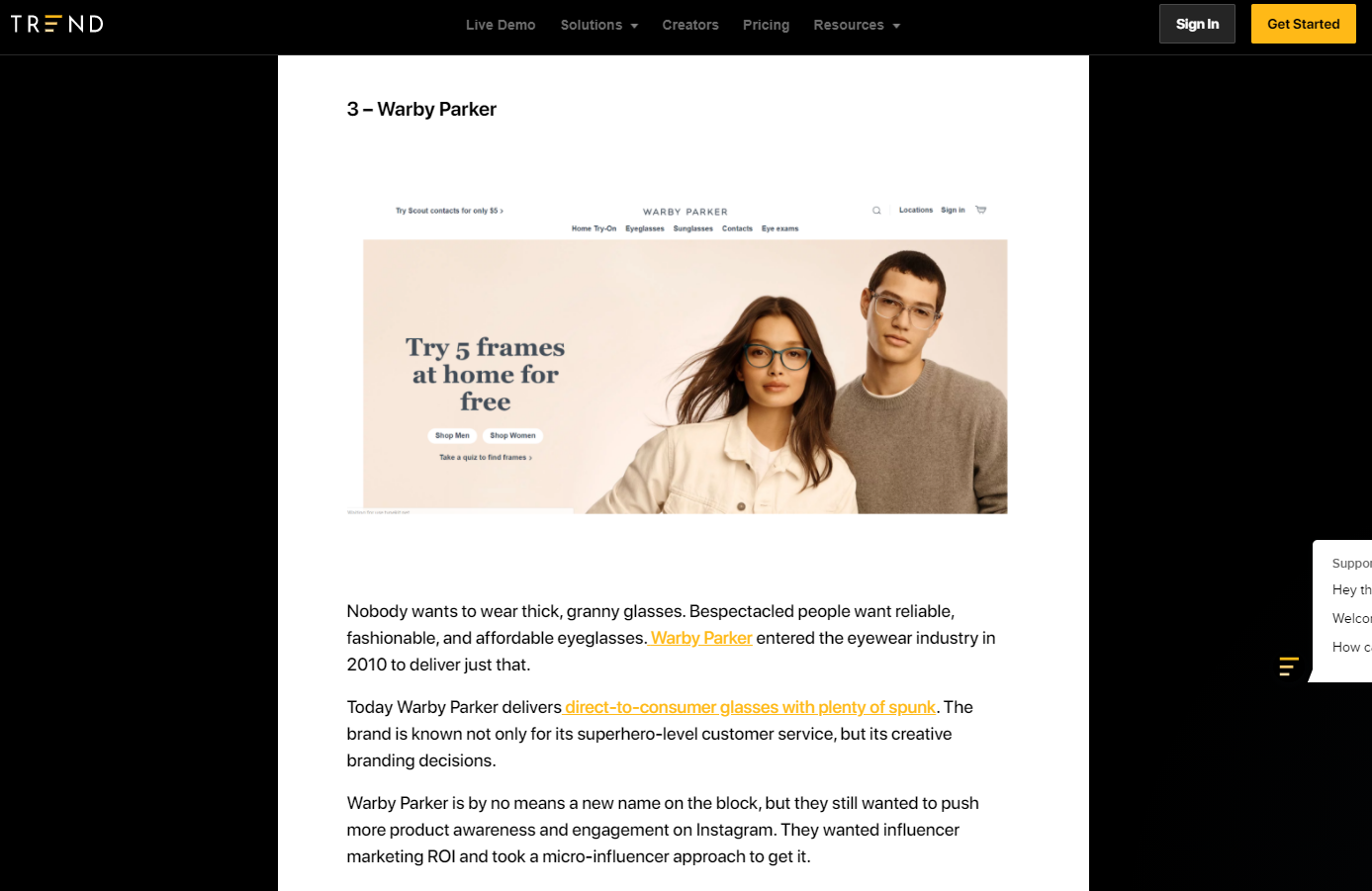
The “Wearing Warby” campaign was centered around showcasing influencers wearing Warby Parker glasses in their everyday life.
From mundane tasks like eating breakfast to artists creating a new masterpiece — it showcased Warby Parker’s products in use and made the brand more approachable for influencers’ followers.
This is another third-person case study, as it doesn’t go into much detail beyond the results.
9. Customer experience case study: App Annie and Coca-Cola
In this case study, Greg Chambers, the director of innovation for Coca-Cola, explains what App Annie brings to the table.
Instead of specific numbers and metrics, it focuses on the big-picture benefits that App Annie has on Coca-Cola’s customer experience.
The video interview format is also perfect for driving trust with potential customers.
Again, this is a typical third-person case study that you see a lot in the marketing world.
10. SaaS case study: Asana and Carta
Of course, it’s not just agencies and advertising platforms that need to master the use of case studies in digital marketing.
Let’s explore an example of a case study outside the marketing industry, in this case specifically for B2B marketers.
Asana is a project management platform that helps companies make their workflows more efficient.
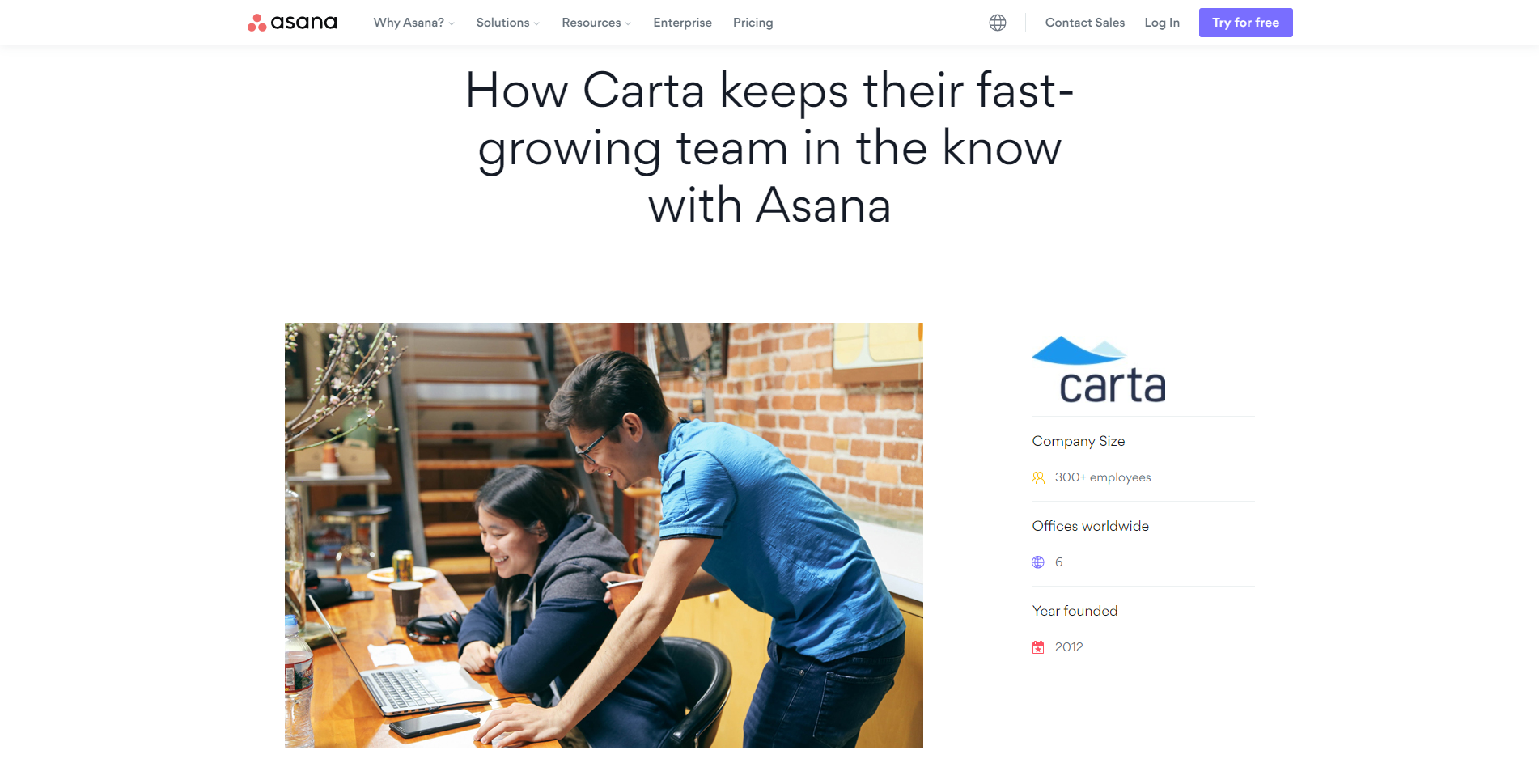
It’s a good example of a case study that focuses more on the lived experience and less on the metrics.
This is a third-person case study that is closer to a client interview or testimonial, which is a good option if it’s hard to quantify improvements with metrics.
Best practices: How to use case studies in your own marketing campaigns
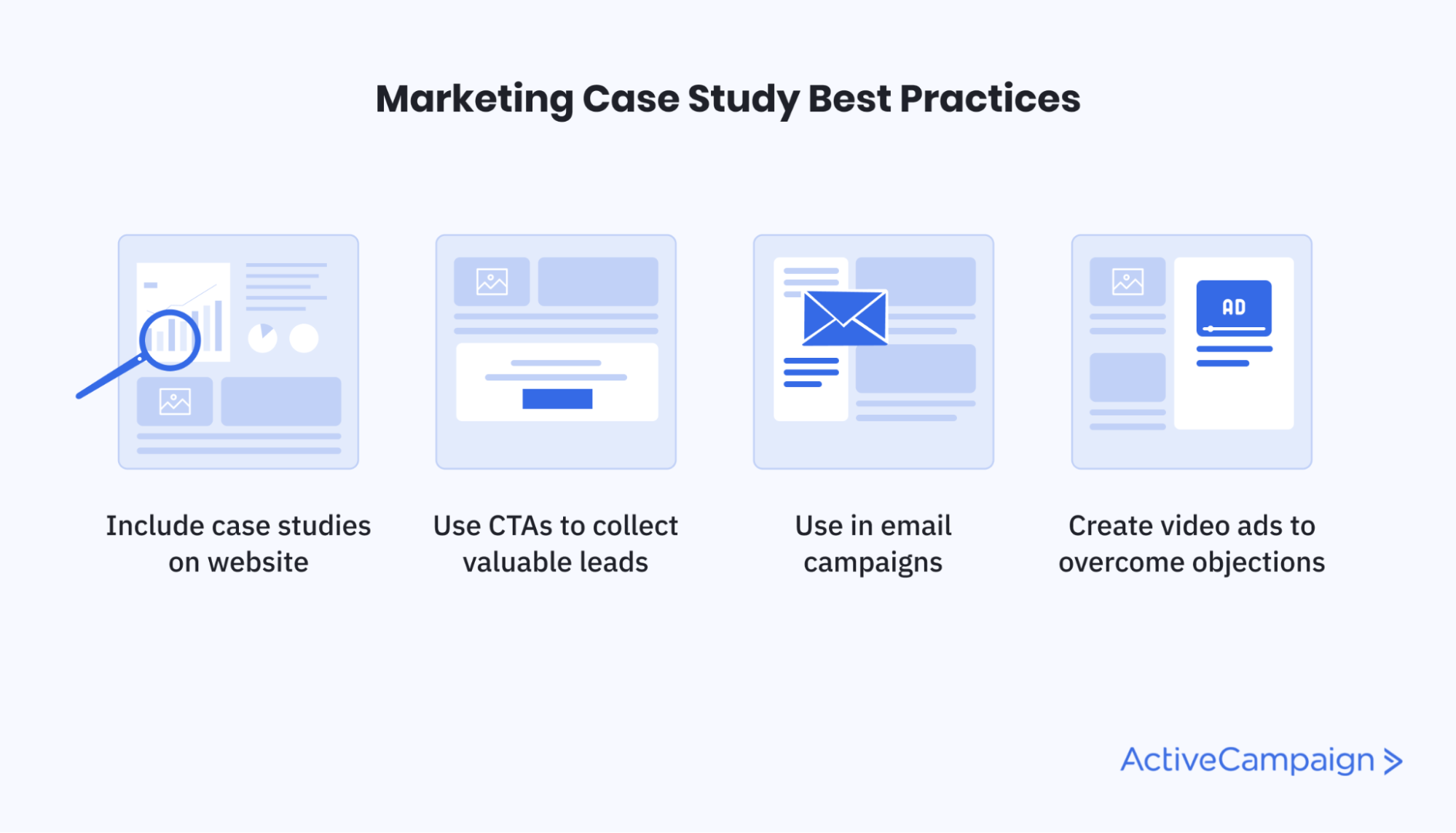
In this section, you’ll learn best practices to help you maximize the value of case studies in your own marketing campaigns.
Let’s look at four steps you can take to effectively use case studies.
Include a dedicated case study/customer stories page on your website
Most companies with a successful online presence have one of these pages. Emulate the top competitors in your industry by creating an improved version of their pages.
You can also add a case studies section to your resources page or blog.
Build CTAs into your case study pages
The chances are low that a random Googler will make it to your case studies. Most likely, it’s someone who thinks they might need your product.
So don’t be afraid to include calls to action throughout your case study pages.
Share case studies as part of your email marketing campaigns
Email marketing is hands-down the best channel for nurturing potential needs . That means you should always use case studies and customer success stories in your campaigns.
But it’s important that it doesn’t feel too promotional. Instead, share the unique steps they took to ensure success to deliver value, not just pitch.
Use case study video ads to overcome objections
When you’re thinking about buying a product, it’s easy to talk yourself out of it.
“It’s too expensive.” “It won’t work for me.” There are a lot of excuses and objections out there.
A case study video can be a powerful tool to overcome these objections in potential buyers.
Don’t overlook case studies when you’re planning your next marketing campaign. Towards the bottom end of the funnel, in stages like decision and action, they’re a powerful marketing tool.
When used right, case studies will help you fill your sales pipeline and provide your sales team with qualified leads.
Hopefully, the examples in this article taught you how you can use case studies in social media, email, and content marketing strategy to further your business goals.
You should also have learned how to use case studies to sell your company’s expertise.
If you want to grow your business, it’s crucial to learn from the people who have gone before you. In marketing, trying to learn all principles from scratch through trial and error would be a costly mistake.
If you’re ready to take advantage of marketing automation and email marketing tools that help similar businesses generate ROIs of 20x or higher, start your ActiveCampaign trial today .
No credit card required. Instant set-up.
Please enter a valid email address to continue.
Related Posts

Mailchimp has long stood as a popular email marketing tool, often chosen for its ease of use and broad range...

SendGrid is a cloud-based email delivery service that assists businesses with transactional email management. It provides robust features, excellent scalability,...

Mobile devices have taken over our lives. Don’t worry, this isn’t an anti-technology think piece. In 2021, people in the...
Try it now, for free

- About / Contact
- Privacy Policy
- Alphabetical List of Companies
- Business Analysis Topics
BMW’s Marketing Mix (4P)
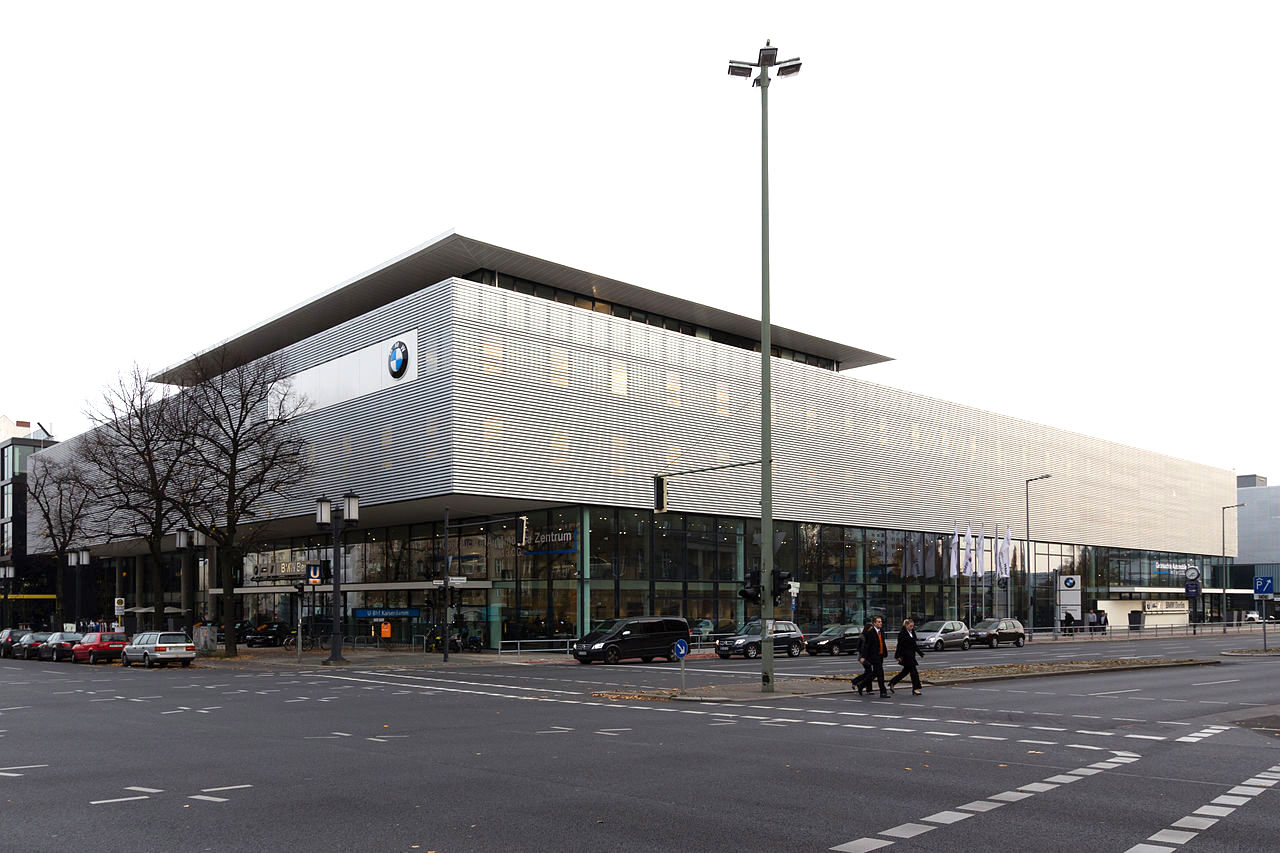
BMW’s marketing mix involves the variables of product, price, place, and promotion (4Ps) used for the automotive and motorcycle business. The company’s marketing strategy sets the premium branding used in this marketing mix for the automotive and motorcycle markets. BMW’s 4P tactics ensure the premium status of the company’s brands, cars, and motorcycles. As the automotive industry changes, so does the company’s marketing mix to maintain product competitiveness against other firms. The effectiveness of this marketing mix in reaching the goals of BMW’s marketing strategy contributes to long-term business success as a manufacturer of premium vehicles for the international market.
BMW (Bayerische Motoren Werke/Bavarian Motor Works) implements its marketing mix and marketing strategy in a technologically innovative industry involving competitors, like Tesla , Toyota , Ford , General Motors , and other automakers, as well as motorcycle manufacturers, such as Harley-Davidson . The Five Forces analysis of BMW shows that these companies operate in a competitive global industry that requires aggressive marketing strategies and corresponding 4Ps.
BMW’s Products
The business outputs offered to target customers (e.g., buyers and drivers) are included in this component of the marketing mix. The following are BMW’s products:
- Automobiles
- Motorcycles
- Financial Services
BMW is known for its vehicles. For cars, the company uses the BMW, Mini, and Rolls-Royce brands. The company’s marketing mix involves the BMW Motorrad brand for motorcycles. The product mix also includes financial services, which are used to facilitate customers’ purchases of the company’s cars and motorcycles. BMW’s competitive strategy and growth strategies influence the products in this component of the marketing mix and the decisions for implementing the marketing strategy. For example, the competitive strategy determines automobile characteristics and branding that are applied or presented in this 4P component.
Price & Pricing Strategy in BMW’s 4Ps
BMW has a premium pricing strategy. This component of the marketing mix sets the price ranges and price points for the company’s vehicles. In BMW’s 4Ps, this pricing strategy applies premium prices that reinforce customers’ perception that the company’s products are in the premium or luxury market segments. As a result, the company’s vehicles are generally more expensive than many competitors, especially Toyota cars. The premium prices reflect how BMW’s marketing mix and marketing strategy differentiate the business and its products through pricing and branding.
The high brand equity and the other competitive advantages discussed in the SWOT analysis of BMW enable the premium pricing strategy in this 4P. The premium branding of cars and motorcycles ensures that premium prices are suited to the company’s marketing mix. The combination of the premium prices and high brand equity is a factor that persuades customers to pay more for BMW’s vehicles. The prices in this marketing mix relate to BMW’s mission statement and vision statement , which specify the strategic focus on mobility solutions and the premium branding used in the company’s marketing strategy.
The locations and channels used in the automaker’s distribution strategy are specified in this component of the marketing mix. BMW reaches its target customers through the following places:
- Dealerships and other sales partners
- Other facilities and parties
BMW’s sales network involves dealerships, which are the most visible and prominent places in this 4P component. Sales partners in some markets function like dealerships. BMW’s marketing mix also uses other facilities and parties, including operations for logistics, to support the distribution of its cars and motorcycles to target customers, while addressing supply and demand in target markets. The location strategy in BMW’s operations management influences strategic decisions regarding the locations of dealerships and other places in this marketing mix. This location strategy coordinates location decisions for an optimal location network in the international market for cars and motorcycles. The geographic divisions in BMW’s organizational structure (corporate structure) reflect the distribution strategy in this marketing mix. For example, these divisions are used for strategic management and marketing strategies involving the dealership network in regional and local markets around the world.
Promotion in BMW’s Marketing Mix
Promotional tactics and practices are determined in this marketing mix to enhance the automaker’s image, to persuade target customers, and to generate more sales. In its marketing communications mix, BMW’s promotion has the following elements:
- Advertising
- Public relations
- Personal selling
BMW advertises through multiple channels and media, including television, print, and online media. Through advertisements, the company’s marketing mix supports brand strength and awareness, especially for promoting new car models. Public relations involve activities that promote the automaker by enhancing its corporate image and brand perception. The initiatives and programs for BMW’s stakeholder management, sustainability, and other ESG and CSR goals are a factor in the company’s marketing strategy and intersect with this marketing mix by enhancing the corporate image and supporting public relations. This 4P also includes personal selling applied at dealerships during in-person communication between sales personnel and interested vehicle buyers. The trends discussed in the PESTEL/PESTLE analysis of BMW provide information, such as social cues, which are used in decisions for the promotional tactics in this marketing mix.
- BMW Group Locations Worldwide .
- BMW Group Report .
- BMW Group Strategy .
- Brands & Business Segments of BMW Group .
- Edinata, P. V., Kuraesin, E., Muniroh, L., & Megawati, D. (2023). The influence of brand image and consumer lifestyle on BMW car purchasing decisions. Journal of International Trade, 2 (1), 18-24.
- Kucuk, S. U. (2023). Marketing Mix Modeling and Coordination. In Visualizing Marketing: From Abstract to Intuitive (pp. 103-115). Cham: Springer International Publishing.
- Lampón, J. F., & Muñoz-Dueñas, P. (2023). Are sustainable mobility firms reshaping the traditional relationships in the automotive industry value chain? Journal of Cleaner Production, 413 , 137522.
- Solberg, C. A., & Durrieu, F. (2023). Patterns of international marketing strategy. Journal of Business & Industrial Marketing, 38 (7), 1532-1544.
- Copyright by Panmore Institute - All rights reserved.
- This article may not be reproduced, distributed, or mirrored without written permission from Panmore Institute and its author/s.
- Educators, Researchers, and Students: You are permitted to quote or paraphrase parts of this article (not the entire article) for educational or research purposes, as long as the article is properly cited and referenced together with its URL/link.
- Blog Extended Marketing Mix Evolution of the Internet Inbound Marketing Personal Branding Content Marketing Search Engine Optimisation Email Marketing
Extended Marketing Mix (7 Ps)
Commonly used in traditional marketing, extended marketing mix, also known as the 7 Ps of marketing (Product, Place, Price, Promotion, People, Process, Physical Evidence), can also be applied to digital marketing. To get an idea of how the 7 Ps are used in the real world, read this case study of what McDonald's extended marketing mix looks like.
McDonald's is best known for its range of burgers such as the cheeseburger and the Big Mac, and their French fries . The fast-food restaurant allows its customers to buy individual items or purchase a meal that includes a drink. In addition to its traditional menu, McDonald's offers a range of hot and cold drinks such as tea, coffee and milkshake. The dessert menu includes the chain's famous Apple pie, McFlurry ice cream, and more. The modern menu is very different from the first McDonald's Franchise restaurant's menu, which included only a handful of items.
How McDonald's Products Changed Over Time
- What was on the original McDonald's menu
- How the menu changed over time
- What influenced the changes
When brothers Richard and Maurice McDonald's opened their 'McDonald's Famous Barbeque' restaurant in California in 1940, little did they know that their small business would go on becoming a global brand. The original restaurant served more than forty barbequed items. However, the brothers soon realised that most of their profit came from selling hamburgers. So in 1948, they redesigned their restaurant by implementing assembly line principles for speedy food preparation and started selling a limited number of items, including hamburgers, cheeseburgers , potato chips, cold drinks and coffee. The following year, the chips were replaced by French Fries and Triple Thick Milkshake was added to the menu. Despite McDonald's becoming a nationwide franchise in 1955 , the menu remained largely unchanged until 1965 when McDonald's franchisee Lou Groen based in Cincinnati, Ohio, created the Filet-O-Fish sandwich to increase Friday sales in his primarily Roman Catholic location. In 1967, a franchisee Jim Delligatti, who operated several McDonald's restaurants in Pittsburgh, created the Big Mac to compete with 'Big Boy hamburger' sold in a nearby Big Boy Restaurant chain's branch. Delligatti started selling The Big Mac in his restaurant in Uniontown, Pennsylvania. However, it proved to be so popular with customers that it was added to the menu of all American McDonald's restaurants the following year. Another product introduced in 1968 was the Hot Apple Pie . The Quarter Pounder was invented in 1971 by another creative franchisee, Al Bernardin, who owned two McDonald's restaurants in Fremon, California. Bernardin concluded that there was a gap in the market for burgers where the meat weights more than the bun. Two years later, the Quarter Pounder and the Quarter Pounder with Cheese were added to the national menu. The Egg McMuffin was the brainchild of Herbert Patterson, who operated a McDonald's franchise in Santa Barbara, California. The invention of the egg sandwich was revolutionary because it created a potential breakfast business idea for McDonald's. However, despite being invented in 1972, The McMuffin was not added to the national menu until 1975. The Happy Meal was created to bring in more families with small children and was added to the national menu in 1979. It comes with a small toy or a book along with food. McChicken sandwich was first introduced in the US in 1980. However, after failing to meet expectations, it was removed from the menu and replaced by chicken McNuggets in 1983 . McDonald's eventually brought McChicken back in 1988. In 1996, it was replaced in the US with the Crispy Chicken Deluxe. But once again, McDonald's started reviving the McChicken in 1997. Currently, McDonald's restaurants all over the world serve an extensive range of chicken burgers and wraps. One of McDonald's most popular desserts, McFlurry , was invented in 1995 in Canada and was added to the international menu in 1997. In 2002, the company committed to being a more responsible and sustainable brand by issuing McDonald's Social Responsibility Report . Since then, McDonald's restaurants started offering healthier options, such as salads and fruit bags , along with their regular items. The chain also significantly reduced the amount of packaging it uses. Perhaps most importantly, McDonald's became more responsible towards animal welfare , undertaking on-site audits of their meat supplier facilities around the world. In addition, the chain has recently introduced their first Vegan Burger, the McPlant , in selected restaurants.
The history of McDonald's goes back to 1940 when the McDonald's brothers opened a small barbeque restaurant in California. In 1948, the brothers refocused on selling burgers, chips, soft drinks and coffee, setting the foundation for the McDonald's we know now. McDonald's became a corporation in 1955 and has been growing ever since. There are now over 37000 McDonald's restaurants in more than 100 countries. The design of McDonald's restaurants differs from country to country and even city to city. However, the yellow arched letter M logo remains the same around the world.
Offering an extensive range of food items, McDonald's has different prices for different products. Having branches all over the world, McDonald's also works with multiple currencies . McDonald's uses Psychological pricing strategy, setting the price of their products lower than a whole number, e.g. £3.99 rather than £4. Another pricing strategy the chain uses is Bundling , offering a discount on the purchase of a full meal to encourage customers to spend more money.
McDonald’s uses TV and online media as one of its main advertising strategies. In addition, the chain uses posters and popular newspapers, such as Metro, to advertise its products. Newspaper promotions often include money off coupons for certain meal options. In-store promotions include the saver menu, limited-time offers on certain items and the Happy Meal , which includes a toy along with a smaller sized meal, to attract families with young children.
McDonald's became a franchise in 1955. Currently, as many as 93% of McDonald's restaurants worldwide are owned and operated by franchisees . McDonald's would not grow to be the large international corporation we all know without these independent local business owners. McDonald's restaurants employ over two million people worldwide, making the chain one of the largest employers in the world. McDonald's refers to its staff as crew members . The crew members are responsible for food preparation, customer service, cleanliness, and hygiene.
McDonald's is a market leader in engineering and process. They have implemented effective processes for ordering, preparing, serving and delivering food over the years. McDonald's makes sure that customers are served as fast as possible, whether they buy food in one of the chain's many restaurants , use a drive-thru , or order McDelivery.
Physical Evidence
The fact that you can find McDonald's restaurants all over the world, including in unusual locations, such as the desert near the Dead Sea in Israel, is clear evidence of the chain's success. McDonald's branding on their product packaging , such as drink cups and French fry and burger boxes, is another evidence of the restaurant's success.
Room for Improvement
McDonald's impressive ability to cater for different tastes and lifestyles is reflected in their marketing campaigns. However, one of the common complaints is that McDonald's restaurants do not offer gluten-free buns. With an increasing number of people suffering from gluten intolerance, it would be a good idea to introduce gluten-free burger options to the menu and include this in the marketing campaign.
About the author
Michaela mrockova, michaela has been working as a web designer and content writer for several years. michaela will be sharing content marketing and seo tips on this blog. .
© Copyright 2023 Digital Marketing Blogger - All Rights Reserved
- Business Cycle
- Business Environment
- Consumer Protection
- Corporate Responsibility
- External Influences
- Globalisation
- Government Influence
- International Business
- Financial Risk
- Investment Appraisal
- Sources of Finance
- Competitive Advantage
- Customer Focus
- International Marketing
- Market Research
- Marketing Planning
- Marketing Strategies
- Product Launch
- Product Life Cycle
- Product Portfolio
- Segmentation
The Marketing Mix
- Continuous Improvement
- Customer Service
- Health and Safety
- Lean Production
- Location of Business
- Management of Change
- Merger and Acquisition
- New Product Development
- New Technology
- Product Development
- Production Process
- Research and Development
- Supply Chain
- Communications
- Developing People
- Equal Opportunities
- Managing Change
- Organising People
- Protecting People
- Recruitment and Selection
- Roles and Responsibilities
- Skills and Competencies
- Aims and Objectives
- Business Expansion
- Business Organisation
- Business Planning
- Business Start-Up
- Business Strategy
- Decision Making
- Sectors of Industry
- Stakeholders
- Strategic Planning
- Types of Organisation
- External environment
- External Environment
- eBook Collections
- Audio Case Studies
- Printed Books By Edition
- Employee Retention
- HR Software
- Hybrid Working
- Managing People
- Motivating People
- Performance Management
- Recruitment
- Time Management
- Training and Development
- Business Acquisition
- Business Growth
- Business Plan
- Business Startup
- Entrepreneurship
- Small Business
- Strategic management
- Types of Business
- Accountants
- Bookkeeping
- Budgeting and Cash Flow
- Business Debt
- Business Financing
- Business Funding
- Business Insurance
- Business Investment
- Business Loans
- Business Payments
- Business Taxation
- Market Trading
- Advertising
- Affiliate Marketing
- Business Branding
- Business Events
- Content Marketing
- Conversion Rate Optimisation
- Customer Experience
- Digital Marketing
- Email Marketing
- Lead Generation
- Link Building
- Marketing Agencies
- Marketing Strategy
- Pay Per Click Advertising
- Public Relations
- Social Media
- Business Efficiency
- Business Innovation
- Business Location
- Business Management
- Business Security
- Manufacturing
- Outsourcing
- Project Management
- Quality Management
- The Supply Chain
- Business Law
- Coronavirus
- Sustainable Business
- The Economy
- Stakeholder
- Ethical Business
- Business of Gambling
- Casino Bonuses
- Casino Games
- Casino Guides
- Mobile Gambling
- Online Casino
- Sports Betting
- Tips and Tricks
- Online Learning
- Schools and Colleges
- Students and Teachers
- Studying Internationally
- Universities
- Writing Services
- Cosmetic Procedures
- Cannabidiol (CBD)
- Cannabis/Marijuana
- Dental Care
- Mental Health
- Office Wellbeing
- Relationships
- Supplements
- Banking and Savings
- Credit Cards
- Credit Score and Report
- Debt Management
- International Money Transfers
- Investments
- Payday Loans
- Personal Insurance
- Personal Law
- Motor Accidents
- Motor Finance
- Motor Insurance
- Motoring Accessories
- Virtual Reality
- Gaming Accessories
- Mobile Gaming
- Online Gaming
- Video Games
- Buying Selling and Renting Property
- Construction
- Property Cleaning
- Property Investments
- Property Renovation
- Business Travel
- Camping Activities
- Travel Guides
- Travel Safety
- Visas and Citizenship
- Antiques and Art
- TV, Film & Music
- Mobile Apps
- Mobile Phone
- Photography
- Digital Transformation
- Crypto Exchange
- Crypto in Business
- Crypto Mining
- Crypto Regulation
- Crypto Trading
- Accessories
- Artificial Intelligence
- Programming
- Security & Privacy
- Software Development
- Web Analytics
- Website Design
- Website Development
- Website guides
- Website Hosting
- Guest Posting
- Membership Billing
- Membership Cancel
- Membership Invoice
- membership levels
- Your Profile
- Account Details
- Lost Password
No products in the basket.

Four P’s of Marketing Mix: A Case Study of McDonald
Adeniran Taiwo Damilola
Market mix consist of the tactics, methods and tools that are being used when trying to attract a potential customer, market mix is a very important market strategy when promoting products it is always made up of very important methods that will keep the business owner on point when targeting a specific market, it also help maintain a very good brand image which sparks the interest of customers or consumers, what the market mix does is that it finds all the important elements of the target market, it also helps identifies how this market are aligned together to increase reach in a marketing plan.
It’s a very important marketing strategy because it helps increase sales (long term sales and short-term sales), Researching the market is a big reason why company’s use the marketing mix, it helps them chose the most feasible products and important values A smart marketing mix is goal-oriented, with each variable adjusted to achieve maximum sales. Marketing mix consist of various methods that help your company have different options or methods to answer customer request when ordering or buying a product. Brand identity is an important aspect of the company’s image, because it is a description of what the brand is and what they can offer and it is determined by the market mix.
STRATEGY FOR MCDONALD’S MARKETING MIX (4 P’S) After analysing the market, identifying critical factors, identifying target categories, and comprehending market demand, every company must develop an offer or other form of plan that would accelerate the company’s growth. McDonald’s employs the four pillars of marketing mix, which are as follows:
- Product : A product is a tangible item or service that a firm provides to its customers. Packaging, guarantee, and appearance are all characteristics of a product. It is also the physical and non-physical part of the product, consumers have the right to spend their money in any place and any time, its very important to not this when presenting them with the menu. As a result, McDonald’s places a high priority on producing a menu that people demand. This is precisely what market research reveals. Customers’ needs, on the other hand, fluctuate throughout time. What is trendy and appealing today may be obsolete tomorrow. Customers’ tastes are constantly monitored by marketing. Due to these changes McDonalds has decided to evolve they stopped the production of old products and invented new ones that with satisfy the different needs of different customer at any given time and these plans is a long-term plan i.e. changes like this will continue to happen in the nearest future. A business should have a good collection of at any given time, each in a distinct stage of development. Some of McDonald’s offerings are becoming more popular, while the Big Mac is probably reaching maturity. It researched customer behaviour in the United Kingdom and created a whole new menu. McDonald’s examined customer behaviour in the United Kingdom and created entirely new menus in comparison to its international offerings. McDonald’s is always evolving its offerings to meet the changing needs and tastes of its customers. McDonald’s brings a well-known brand, world-class food quality, and exceptional customer-specific product features to the table.
- Place : place is the location where good and services are produced, but when it comes to Marketing Mix place is not only stereotyped to where goods and services are produced, it generally involves the monitoring of the process of how goods and services are transferred to a consumer, the distribution channels make up the majority of the space. It also involves making sure the products are being delivered to the consumer at an appropriate time, At the exact location and the right quantity. Each visit to McDonald’s is associated with a particular level of enjoyment and satisfaction. It provides a clean setting, pleasant ambiance, and excellent service. McDonald’s has now begun to offer internet access at locations that also play music. They also provide play places for children while their parents spend valuable time together.
- Price : The price charged is heavily influenced by the customer’s perception of value. Customers create their own mental image of a product’s value. To a consumer the product is more than just what he is buying, the product causes the buyer psychological implication, the risk of employing cheap pricing as a marketing tactic is that the buyer would believe that low price equals inferior quality. When settling on a pricing, it’s critical to understand the brand and its reputation. Reducing prices has a great disadvantage, when prices are reduced, fellow competitors will come down to your level or even more than that and this will result in no additional demand. By reducing the price, you are cutting off the profit to increase sales which might result in negative outcome if the competitors react Same way as you. Pricing is the most important pillar of marketing mix because it is used to make more income, the remaining four are business -related charges. The suitable demand supply equation must be considered while setting the price. McDonald’s came up with a clever comeback. To boost total sales, McDonald’s uses value pricing and bundling methods including “happy meal,” “combo meal,” and “family meal.”
- Promotion : All sorts of marketing communications are covered by promotions. Advertising is one of the strategies used. Advertising is done on TV, radio, in the movies, online, and so on. Building market advertisement is totally different from the normal advertising, the normal advertising involves paying media owners to publicize your product and without the Payment it won’t be publicized. Sales promotions, point-of-sale displays, and merchandising are examples of other promotional strategies. The product will use a variety of promotion methods to successfully communicate product information, as shown above. A comprehensive grasp of the customer value assists in determining whether the promotion expense is worthwhile. The product advertising has three major goals: to make consumers aware of an item, feel good about it, and remember it. The right message must be delivered to the right audience via the appropriate medium. It will be advertises on television, billboards, and bus shelters. You Deserve a Break Today, so Get Up and Get Away- To McDonald’s” is one of McDonald’s most renowned marketing efforts. “Food, people, and fun” “I’m really enjoying it” McDonalds uses these five promotion tools (advertising, personal selling, sales promotion, public relations, and direct marketing) to integrate a marketing communication program that allows the company to access communication channels clearly and consistently so that messages and products can be easily transferred to customers.

Written by Adeniran Taiwo Damilola
Hi, I am Adeniran Taiwo. I am a freelance writer, I enjoy helping people through my writing. Contact me: [email protected]
Text to speech
1.2 The Marketing Mix and the 4Ps of Marketing
Learning outcomes.
By the end of this section, you will be able to:
- 1 Define and describe the marketing mix.
- 2 List and explain the 4Ps of marketing.
Marketing Mix Defined
Having a great product or service is just the first step in establishing a successful business or building a successful brand. The best product or service in the world won’t translate to profits unless people know about it. How do you reach customers and help them connect with your product? That’s the role of the marketing mix.
The marketing mix is commonly referred to as the tactics a company can use to promote its products or services in the market in order to influence consumers to buy. The marketing mix is also known as the 4Ps: product, price, place, and promotion (see Figure 1.4 ). Let’s look more closely.
- The product is the good or service that the company provides.
- The price is what the consumer pays in exchange for the product.
- The place is where the product is purchased.
- Promotion is comprised of advertising, sales, and other communication efforts the company utilizes to attract the customer.
The 4Ps of Marketing
To this point, we’ve been talking marketing in somewhat of an abstract manner. Instead of continuing with a theoretical discussion of the marketing mix and the 4Ps of marketing, we’re going to approach these topics using an example of a product you probably already own—a backpack. Let’s get started.
Remember: product refers to a good or service that a company offers to its customers. Let’s consider a product that many of you likely own as a college student: a backpack (see Figure 1.5 ).
In terms of the first of the 4Ps, marketing analyzes the needs of consumers who buy backpacks and decides if they want more and/or different bags. For example, marketing will analyze what features consumers want in the bag. Do they want a water bottle pocket, padded shoulder straps, reflective tape, a padded laptop sleeve, or organizer pockets? Think about your own bag for a moment: Why did you buy this particular product? What features did it have that made it appealing to you?
Armed with market research knowledge, marketing then attempts to predict what types of backpacks different consumers will want and which of these consumers they will try to satisfy. For example, are you selling bags to adults for their children’s use? Are you selling them to young adults who might want more (or different) graphics on the bag? Are you selling to adults who will use these bags for work or for school?
Marketing will then estimate how many of these consumers will purchase backpacks over the next several years and how many bags they’ll likely purchase. Marketing will also estimate how many competitors will be producing backpacks, how many they’ll produce, and what types.
Price is the amount consumers pay for a product or service. There’s a delicate balance here. On one hand, marketers must link the price to the product’s real or perceived benefits while at the same time taking into consideration factors like production costs, seasonal and distributor discounts, and pricing product lines and different models within the line.
Marketers attempt to estimate how much consumers are willing to pay for the backpack and—perhaps more importantly—if the company can make a profit selling at that price. Pricing products or services can be both an art and a science. In the case of our backpack example, the company wants to determine two things:
- What’s the minimum price that the company can charge for the backpack and still make a profit?
- What’s the maximum price that the company can charge for the backpack without losing customers?
The “correct” answer usually lies somewhere in between those points on the price continuum.
Promotion includes advertising, public relations, and many other promotional strategies, including television and print advertisements, internet and social media advertising, and trade shows. A company’s promotional efforts must increase awareness of the product and articulate the reasons why customers should purchase their product. Remember: the goal of any promotional activity is to reach the “right” consumers at the right time and the right place.
In terms of our backpack example, marketing now needs to decide which kinds of promotional strategies should be used to tell potential customers about the company’s backpacks. For instance, should you use TV advertisements to make customers aware of the backpack? If so, you’ll want to run your commercials during programs that your target audience watches. For example, if you’re selling backpacks to children (or trying to entice them to badger their parents to purchase them), children’s cartoons may be the most cost-effective avenue to reach your target market. If your backpacks are designed for work or school, you’ll likely decide to advertise on television programs that target younger adults.
Link to Learning
Netflix, jansport, and stranger things.
A real-world promotional example is the recent brand partnership between Netflix and JanSport , the backpack company. These two companies collaborated on a Stranger Things –branded backpack with the launch of the fourth season of Stranger Things in 2022. This collaboration created five Hawkins-inspired backpacks centered on various Stranger Things themes. Read more about this promotion and see the backpacks here .
Perhaps you’ll decide to run magazine print ads. If so, you’ll need to decide in which magazines you’ll place the ads. Most magazines have a very specific readership demographic consisting of factors such as age, gender, and interests. If you’re going to advertise those backpacks with print ads, you’ll want to leverage readership demographics to ensure that your message is being seen by the right consumers—those who are most likely to buy your backpacks. 18
What about internet advertising? Internet advertising (sometimes known as online advertising or digital advertising) is a promotional strategy in which the company utilizes the internet as a medium to deliver its marketing messages. If you’re going to go the digital route, what types of internet advertising will you use? Search engine marketing? Email marketing? Social media ads? TikTok videos?
Place considerations focus on how and where to deliver the product to the consumer most likely to buy it. Where did you buy your backpack? Did you buy it in a big box store, online, in an office products store, or perhaps even the school bookstore? Once again, through market research, marketers determine where potential customers will be and how to get the company’s backpacks to them.
One important factor to note about the importance of place in the marketing mix is that it doesn’t refer to the location of the company itself but rather to the location of the customers or potential customers. Place deals with strategies the marketer can employ to get those backpacks from their present location—a warehouse, for example—to the location of the customers.
Knowledge Check
It’s time to check your knowledge on the concepts presented in this section. Refer to the Answer Key at the end of the book for feedback.
- Positioning
As an Amazon Associate we earn from qualifying purchases.
This book may not be used in the training of large language models or otherwise be ingested into large language models or generative AI offerings without OpenStax's permission.
Want to cite, share, or modify this book? This book uses the Creative Commons Attribution License and you must attribute OpenStax.
Access for free at https://openstax.org/books/principles-marketing/pages/1-unit-introduction
- Authors: Dr. Maria Gomez Albrecht, Dr. Mark Green, Linda Hoffman
- Publisher/website: OpenStax
- Book title: Principles of Marketing
- Publication date: Jan 25, 2023
- Location: Houston, Texas
- Book URL: https://openstax.org/books/principles-marketing/pages/1-unit-introduction
- Section URL: https://openstax.org/books/principles-marketing/pages/1-2-the-marketing-mix-and-the-4ps-of-marketing
© Jan 9, 2024 OpenStax. Textbook content produced by OpenStax is licensed under a Creative Commons Attribution License . The OpenStax name, OpenStax logo, OpenStax book covers, OpenStax CNX name, and OpenStax CNX logo are not subject to the Creative Commons license and may not be reproduced without the prior and express written consent of Rice University.
- Deutschland
- Asia, Australia & New Zealand
- Europe, Middle East & Africa
- United States & Canada
- Latinoamérica
Marketing mix models are based in science, but also need a touch of art
Prema Sampath, group product manager at Google, leads a product team that develops measurement applications for brand advertising, including privacy-centric, third-party solutions for YouTube ads. Stephen Mangan is an ROI measurement manager at Google, leading research and measurement partner activations to help advertisers improve their media optimization strategies.
Marketing mix models (MMM) help marketers make apples-to-apples comparisons across all of their different investments. They provide answers to questions like: What drove sales? What was my ROI? How do I optimize my marketing investment?
But determining ROI takes more than a single calculation. Today’s media landscape is only becoming more fragmented and intertwined, presenting MMMs with an unprecedented challenge when predicting future performance.
Incorporating business context to shape the MMM is an art, one with implications for the model’s outcomes and final recommendations.
To make sense of the MMM, advertisers often defer to their measurement providers’ technical expertise. But there is more to the measurement strategy than the science behind the model. Incorporating business context to shape the MMM is an art, one with implications for the model’s outcomes and final recommendations. Advertisers who embrace that art can empower their businesses to make more strategic measurement-based decisions.
Here are three steps marketers can take to embrace the art of the MMM.
Start with granularity
Remember that impressions are not equal across platforms or even within them. When it comes to video-specific measurement, MMMs will evaluate all of your impressions, but platforms can vary widely in terms of watch time, viewability , and audibility. The same data can produce very different results depending on how it’s incorporated into the model. Research we commissioned from Nielsen shows that when CPG brands’ MMMs evaluated individual video platforms rather than aggregated data, return on ad spend (ROAS) varied by as much as 48%. 1
Ad formats can vary just as widely. On YouTube, for example, ads can range from unskippable 30-second videos to a 6-second bumper ad. While both formats can deliver ROI, the cost and effectiveness of their impressions won’t be the same.
The same data can produce very different results depending on how it’s incorporated into the model.
So be sure to leverage the most granular data from your publishing partners, and your model will be able to identify the respective value of different impressions. As with any model, the MMM has limits. But every layer of granularity will lead to more informed business decisions.
Add business context
The science of the MMM can tell you what your ROI was, but it can’t tell you why without context. Getting granular, format-level data is a start, but formats are only one driver of ROI. According to Nielsen Catalina Solutions, creative accounts for 47% of video ROI — and yet, MMMs are not designed to evaluate individual creative assets.
Collaboration will help your measurement provider evaluate how these changes in strategy impact ROI. Done right, this can lead to more ROI over time.
"If modeling is done in a vacuum, devoid of context, it could lead to misleading and suboptimal decisions,” said Rajika Karunanayaka, senior manager of media sciences at Hershey. “So context is just as important as the data that goes into modeling and should be a key consideration every step of the way.” Hershey’s Integrated Media team works with IRI to get data from Google and contextualize changes in their media plans, she said.
Work with your publisher partner to gather insights around your media buy and identify any other data needed for the model to answer strategic business questions. Collaboration will help your measurement provider evaluate how these changes in strategy impact marketing ROI. Done right, this can lead to more ROI over time.
“We partner with Google to collect MMM data at the right level of granularity to enable actionable and insightful modeling, and then work with them to review the underlying executional elements that could potentially play into the results,” said Karunanayaka, citing changes to Hershey’s YouTube ad format mix, reach and frequency, audience strategy, and viewability as possible sites of impact. “We also work with our Google team to understand effectiveness at the creative level, while normalizing for ad format so we can get a sense of which Hershey YouTube ads are driving sales.”
In an MMM meta-analysis we commissioned from Nielsen, on average, YouTube ROAS grew by 108% for brands after collaborating 2 with Google, a 7X greater increase compared to brands that did not collaborate with Google. 3 Sharing your media narrative will allow the modelers to understand what influenced changes in marketing ROI, and will ultimately help you formulate smarter business strategies.
Create more transparency
No model is perfect, MMM included. A team of Google data scientists even published a paper on how MMMs using the same data could report drastically different ROI with the same level of statistical confidence.
With that in mind, assess results from a critical lens. Rather than accept all outputs, ask your measurement provider about the model’s margin of error for specific results and recommendations. Don’t base any important business decisions solely on your MMM as a single source of truth. Instead, take the time to design a test versus control experiment that can give you a second perspective on the model’s accuracy.
The art of enhancing the model is where marketers can step in to help gather data and context from publisher partners and push providers on transparency.
MMM is a valuable tool for measurement, but science alone cannot produce all the right answers. Nuance matters. The art of enhancing the model is where marketers can step in to help gather data and context from publisher partners and push providers on transparency. With these small steps, teams can influence the structure and enhance the accuracy of the MMM, leading to outcomes that enable more informed decision-making.
Others are viewing
Marketers who view this are also viewing
How to maximize a full-funnel media strategy with measurement
How subway maximizes the impact of marketing mix modeling to drive growth, how to build a full-funnel influencer marketing campaign, the ai handbook: resources and tools for marketers, driving growth in a changing privacy landscape: the digital marketing playbook, understanding the abcds of effective creative on youtube, prema sampath, stephen mangan, sources (3).
1 Google-commissioned Nielsen MMM Meta-Analysis, U.S., studies from CPG clients, base: n=20, 2016–2018.
2 Collaboration is defined as brands who share YouTube ROAS results and consult with Google on optimization. ROAS is defined as incremental offline retail sales per dollar spent.
3 Google-commissioned Nielsen MMM Meta-Analysis, U.S., studies completed between 2015-2017 (pre-period) and 2019-2020 (post-period), base: a list of MMM studies selected and compiled by Nielsen, consisting of 132 brand/category combinations that collaborated with Google on MMMs as well as 140 brands that did not collaborate with Google, 2015–2017 and 2019–2020.
Others are viewing Looking for something else?
Complete login.
To explore this content and receive communications from Google, please sign in with an existing Google account.
You're visiting our United States & Canada website.
Based on your location, we recommend you check out this version of the page instead:
The Evaluation of Marketing Mix Elements: A Case Study
International Journal of Social Sciences & Educational Studies, March 2018, Vol.4, No.4
10 Pages Posted: 17 May 2018
Thabit Thabit
Ninevah University
Manaf Raewf
Cihan university.
Date Written: March 1, 2018
The paper aims to investigate the influencing of marketing mix (MM) elements (product, price, place or distribution, and promotion) on increasing the effectiveness of product promotion and their role to reduce the problems within the organization. The main important aspects of this paper are to discuss the theoretical part of MM, to provide some perspectives for the researchers, and to give some instructions for the marketing department in Al-Saaeda Company for medical equipment technologies. The researchers used the main related academic resources from the university library, and internet and they designed and distributed questionnaires on a random sample of Al-Saaeda Company for Medical Equipment Technologies customers and the company employees to measure the impact of promotion on the marketing of its product (Glucocard 01-mini plus). The main findings of this paper can be concluded as follows: 1. The promotion has a very high level of impact to increase the sales of products. 2. The good distribution of the product can affect positively on customer satisfaction. 3. The company's policy for promoting has a very good reflection on increasing the sales of products. The researchers recommended that the company must strengthen the level of promotions in its activities and departments, and the increase of sales points is very important, so the company must enhance its policies of distribution.
Keywords: Marketing Mix, 4P, Price, Place, Product, Promotion
Suggested Citation: Suggested Citation
Thabit Thabit (Contact Author)
Ninevah university ( email ).
Al-Majmoaa St. Mosul, Ninevah 41002 Iraq
Street 100M Erbil, Kurdistan Region 0383-23 Iraq
Do you have a job opening that you would like to promote on SSRN?
Paper statistics, related ejournals, innovation & management science ejournal.
Subscribe to this fee journal for more curated articles on this topic
Industrial & Manufacturing Engineering eJournal
Member-only story
A Complete Guide to Building a Marketing Mix Model
Fully understand what a marketing mix model is and how to use one.
Terence Shin, MSc, MBA
Towards Data Science
Introduction
Marketing was always considered more of an art than a science. But with the emergence of online marketing and big data, marketing is more mathematical and methodical than ever. In fact, one of the biggest areas of…

Written by Terence Shin, MSc, MBA
Data Scientist @ Cash App | Health fanatic | Educator | https://www.linkedin.com/in/terenceshin/
Text to speech
Detailed Marketing Mix of Adidas: How Sportwear Giant Reaches its Target Audience
By Aditya Shastri
In this blog, you will be able to learn more about the marketing mix of Adidas shoes which is known as one of the leading sportswear brands in the world. Discover and learn about how the company leverages its products, pricing, place, creation, and people in order to reach its target audience.
Adidas uses “Impossible is Nothing” as its tagline and has even proved it for itself. A prominent sportswear manufacturing company today, it came into the headlines and became world-famous in 1954 after the great victory of the German team in the World Cup, the “miracle of Berlin”. Adidas was also listed in Forbes’s most valuable companies list in 2020. In recent years, despite facing some challenges, the financial performance of Adidas has been better than ever. The company has noticed a 5% decrease in revenue in the year of 2023 as compared to 2022. However, the total revenue made was € 21,427 million that is approximately 22.4L million INR.
The company has set a goal to attain carbon neutrality by 2025 as well as making an investment in new technologies that include 3D printing and recycled materials, to reduce its impact on the environment. Adidas has worked continuously on increasing its partnering with high-profile brands such as Beyonce, Kanye West, and Pharrell Williams. This has helped the brand to increase its reach to new audiences and increase its brand awareness. With a strong brand presence, a global reach, and a commitment to introduce innovations, the company has a positive future. In this blog, we will learn the detailed marketing mix of Adidas, digital marketing strategies, and top competitors.
About Adidas

Adidas is a German Multinational corporation founded in 1959 by Adolf Dassler, headquartered in Herzogenaurach, Germany. It is one of the oldest footwear brands that is still considered a major style statement by youngsters worldwide. Even after facing intense competition from the traditionally competitive US sportswear market, Adidas through its creative and appealing marketing campaigns has managed to remain one of the leading brands in the world.
Having operations in over 100 different countries, Adidas is a large and multifaceted organization that employs 62000 people all over the world. Since its establishment, Adidas has opened its successful brand subsidiaries including Reebok , TaylorMade, and Runtastic.
Now that we have a brief about the company, let us dive straight into Adidas’ Marketing Mix
What’s new with Adidas?
- Adidas is in talks with Bata, the Indian shoemaker to form a strategic partnership in the Indian market. Bata’s 2100 retail stores located across 700 cities, offer an amazing opportunity for Adidas to expand its reach.
- Adidas collaborated with multiple award-winning Nigerian singer, Adekunle Gold, and unveiled its latest wear by making him model the latest Manchester United Adidas LFSTLR collection.
- Adidas, the sportswear giant announced the launch of its latest running shoes, the Switch FWD. These shoes were focused on beginners with the theme, of “forward momentum”, on the press.
- Addidas updates its classic Stan Smith shoe for its new season w ith the Adidas Originals CG Boost Stan and CG Split Stan. This update took place with an ongoing collaboration with Craig Green, the British designer.
- Adidas’s latest online sales campaign for the unsold inventory of Yeezy shoes was a huge success with orders exceeding $565 million dollars. This unexpected demand resulted in temporary shortages.
- Adidas is funding projects in areas hit by extreme weather for a second year, showing commitment to climate action and community support.
- Adidas Originals has partnered with Chinese designer Dingyun Zhang to introduce their first collaborative shoe: a fresh interpretation of the iconic Samba sneaker, showcasing innovative design elements.
- Adidas unveils its SS24 Paris Collection, consisting of 15 pieces tailored for the upcoming clay season in 2024. Designed to aid players in adjusting to clay court conditions, the collection features a core range of 8 apparel and footwear items. Additionally, it aims to promote awareness of Adidas’ annual Move For The Planet initiative.
- Adidas adds Xochitl Gomez to its global family, recognizing her as a rising star in film, fashion, and activism. She’ll represent the Sportswear category.
- Adidas teamed up with Adaptive Sports Northwest (ASNW), a Portland-based non-profit, to design adaptive basketball uniforms tailored for wheelchair and seated athletes.
- Adidas surpassed expectations in the first quarter of 2024, propelled by strong brand momentum.
Buyer Persona

Buyer’s Persona
Profession:
Marketing Manager
- Staying active and healthy
- Looking stylish
- Brand-freak
- Celebrity Merchandise
Interest & Hobbies
Pain points.
- Not having enough time to work out
- Not being able to find affordable workout clothes that are also stylish
- Not knowing which brands are committed to sustainability
Social Media Presence
- Active on Instagram and Twitter
- Follows a lot of fitness influencers
- Engages with brands that he likes
Marketing Mix of Adidas
Marketing Mix refers to the foundation model of any business which is centred around mainly the 7Ps which are product, price, promotion, place & distribution, people, process and physical evidence. Companies lay out strategies and marketing techniques around these to reach out to their target audience to achieve their marketing objectives.
Let us understand the following 7 Ps of Adidas-
1. Marketing Mix of Adidas: Product Mix
Adidas deals in various product lines including footwear, apparel, accessories, football kit, golf equipment, etc. The range of Adidas product mix is also divided according to different sport games for which Adidas provides kits and equipment. Some of the sports games where the company majors in supplying the team kits globally are: Association football, Baseball, Basketball, Cricket, Gymnastics, Ice hockey, Lacrosse, Running, Skateboarding, Tennis, Kabaddi, and Golf.
Adidas has gained huge popularity by opening its subsidiaries including Reebok, Runtastic, TaylorMade, and Rockport. Though there are around 110 subsidiaries of Adidas Worldwide, the subsidiary that overtaken Adidas itself is Reebok footwear and apparel. Whereas Runtastic is a digital health and Fitness app, TaylorMade is centred on golfing clothes and Rockport offers outdoor footwear, apparel and accessories.
Though this company offers various products, its major product line is Footwear. Given that Adidas’ foundation was built on footwear itself, its footwear is still deemed the most robust and athletic in the market, followed by its apparel and accessories.
The product strategy of Adidas focuses on three key areas:
- Sustainability: Being committed to sustainability, the company uses recycled materials in its products and invests in technologies such as 3D printing, to reduce enviromental impact.
- Innovation: Adidas is always searching for new ways to improve their products.They are known for having a good track record when launching new products that are both innovative and popular with consumers.
- Performance: Adidas product mix are designed with the aim of helping these athletes play their A game. For this purpose, the company works with athletes to develop products that meet their needs and requirements. Tests are run to make sure that the product meets these requirements.
Adopting this product mix of Adidas, has helped the company to be a part of the leading sportswear brand in the world. The dedication of the company towards sustainability, innovation and performance has increased the popularity of its products around the world.

2. Marketing Mix of Adidas: Price strategy
Another aspect of the Adidas marketing mix is the pricing strategy. Adidas includes Skimming Pricing and Competitive pricing in its marketing mix. Adidas pricing strategy is competitive prices are used for its mill products to compete with brands like Nike and Puma and skimming prices are used for the newly introduced products in the market.
Under Skimming pricing, high prices are kept for newly launched products to maintain exclusivity and gradually the prices are reduced with time until it reaches the market average.
When it comes to Apparel, Adidas pricing strategy mostly uses skimming price because of its brand equity. Thus, the Target audience of Adidas includes the upper-middle class as well as high-end customers.
Matter of fact, the High-price strategy of Adidas makes it a luxury brand among people. Folks go for Adidas even when the prices are high because psychologically, they think that high prices mean high quality and confirmation of authenticity.
Adidas’s pricing strategy is created based on the following factors:
- Brand Equity: Adidas, being a well-known brand, is known for offering high quality products. This gives the company the opportunity to offer premium prices for its product offerings.
- Target Market: Adidas targets upper-middle-class and high-end consumers because they are willing to pay a premium price for these high-quality and exclusive products.
- Product life cycle: Adidas pricing strategy employs price skimming strategies when introducing new products so that they can earn as much as possible before its competitors introduce similar variations of its products. When the product meets the maturity stage the company will have to resort to competitive pricing strategy.
This pricing strategy has helped the company in successfully achieving its marketing objectives. This has helped the company to position itself as one of the leading sportswear brands in the world, which has been able to generate significant profits.
3. Marketing Mix of Adidas: Place & Distribution Strategy
The third one in the Adidas marketing mix is the place and distribution strategy of the product. Adidas has its production houses in around 55 countries and has 800 factories pinned across different continents. The major source through which its products are sold is Retail Stores i.e., Adidas outlets. It has more than 2800 retail outlets globally.
The place and distribution strategy focuses on making its products available in a variety of convenient locations. The company’s distribution strategy includes the following:
- Retail Stores: Adidas owns retail stores in Major cities around the world offering wide range of Adidas product mix and providing opportunities to consumers to try the products and get some amazing advice from sales associates.
- Online Retailers: Adidas sells its products through various online platforms such as Amazon, Foot Locker, and JD Sports. Consumers will be able to buy products from Adidas by just sitting at home.
- Wholesale distributors: Here Adidas basically sells its products to the wholesalers. These wholesalers later distribute these products to the retailers. This channel helps Adidas reach a wider audience.
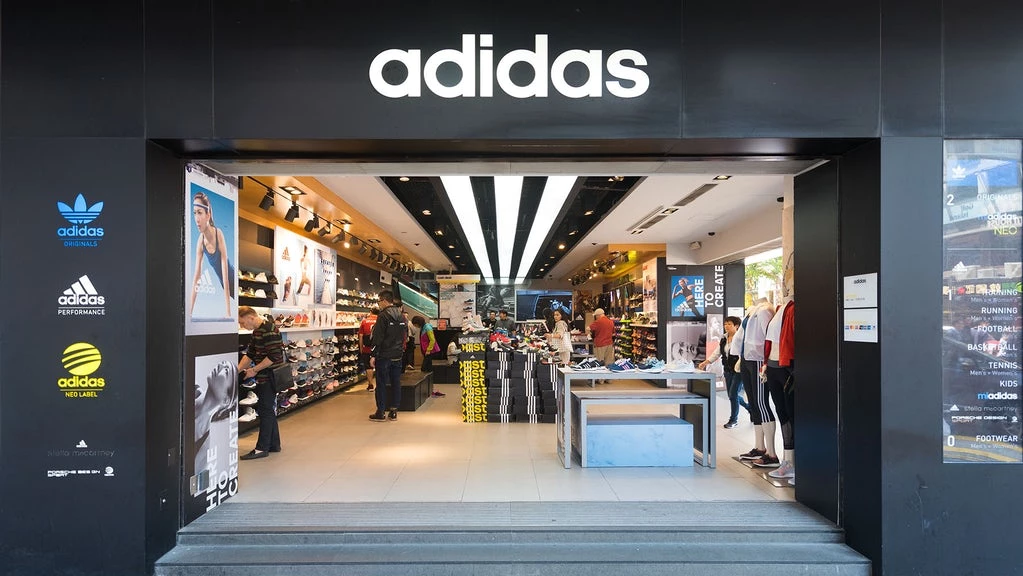
This place and distribution strategy has successfully helped the company to achieve its marketing objectives. This has helped the company to be one of the leading sportswear brands in the world in order to generate higher sales.
4. Marketing Mix of Adidas: Promotion Strategy
This one is the most important part of the Adidas marketing mix strategy. It is a well-known fact that the TV ads of Adidas are Adrenaline pumping. Knowing that Adidas’ strength is derived from sports, their ads are robust and passionate. The major source of promotion for Adidas is marketing through television.
Another major promotion method of Adidas is product placement. Product placement means where references to brands are made by featuring them in other works like movies and television programs. The popularity of Adidas is also because of all its tie-ups with sports icons such as Lionel Messi and Ronaldo.
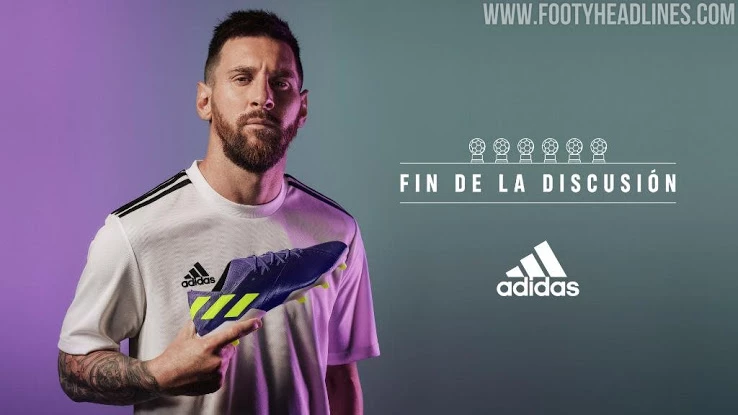
Along with tying up with major sports celebrities, Adidas also sponsors some popular sports teams such as Real Madrid and in football, Great Britain which helps the company in building its brand image.
Apart from this, Adidas has been known for its creative marketing campaign and event marketing. Social Media is another way through which this company keeps up with folks across the world. There are millions of followers of Adidas on both Facebook and Instagram . The sports angle in their social media handle makes it more magnetic and appealing.
The most recent campaign by Adidas “Own the Game” was introduced on virtual investor and media day. The campaign is to strengthen and uplift the authenticity of the brand and proliferate the company’s activity in sustainability. This campaign has been created with the expectations of sales and profitability until 2025.
Adidas has recently announced that actress Jenna Ortega will be the face of its new Sportswear label and the “All That You Are” campaign. The campaign promotes comfort and self-expression and features diverse creatives and athletes. Ortega, who starred in the Netflix series “Wednesday,” is the newest addition to Adidas’ global family.

The promotion strategy of Adidas focuses on creating awareness of its brands and products. The promotional tools used here include the following:
- Advertising: Adidas uses various media to promote its products such as television, print, and online. Creating and visually appealing campaigns are created to capture the eye of consumers.
- Sponsorship: Adidas sponsors the sports events such as the FIFA World Cup and Lionel Messi. Through sponsorships, the brand reaches a wider audience in order to make the audience resonate with the brand with success.
- Public Relations Activities: Adidas indulges in press releases as well as organizes events to generate a positive public image of the brand. These public relations activities help the brand to create awareness as well as position itself as a leader in the sportswear industry.
- Digital Marketing: Adidas leverages the power of digital marketing tools such as social media, SEO and SEM, and content marketing, in order to reach their online audience. Engaging in such activities has helped consumers to build brand awareness and increase website traffic. These promotion strategies have been a huge success in helping the company to achieve its marketing objectives and increase sales.
5. Marketing Mix of Adidas: People Strategy
Adidas’s people strategy focuses on attracting, developing, and retaining some of the best talent in the industry. The company strongly believes its people to be one of the most important, as a result, they invest heavily in its people development programs.
Thus, the people strategy of Adidas includes the following:
- Attracting good talent: By offering competitive salaries and benefits, it has created a strong brand reputation. This allows the company to attract people with good talent across the globe.
- Developing those talents: By offering a variety of training and development programs, Adidas helps its employees inculcate new skills and knowledge. Adidas encourages its employees to take risks and grow within the company.
- Retaining these talents: The company promotes a positive work environment and strong teamwork within the organization which helps to retain these amazing talents.
This strategy adopted by Adidas has been successful to help the company to achieve its business goals. As a result, the company has developed such a strong team that is committed to the growth and success of the organization.
6. Marketing Mix of Adidas: Process Strategy
The process strategy of Adidas focuses on improving efficiencies by streamlining its operations. A variety of tools and techniques are used to improve its efficiency that including:
- Lean Manufacturing: Adidas adopts lean manufacturing practices to reduce its waste and improve efficiency. This manufacturing is one of the systematic approaches to reduce waste by focusing on identifying and eradicating non-value-added activities.
- Six Sigma: These principles help Adidas to improve the quality of its products and processes. Six Sigma makes use of data and statistical analysis in order to identify and eliminate defects.
- Business Process Management (BPM): In order to improve the efficiency of its business processes, Adidas makes use of BPM. BPM, being a discipline makes use of a variety of tools and techniques to improve the design, execution and monitoring of these business processes.
This process strategy has successfully helped the company to reduce its costs, improve quality, and increase efficiency.
7. Marketing Mix of Adidas: Physical Evidence Strategy
Adidas uses this strategy to generate a memorable experience for its customers. Adidas’s physical evidence strategy includes its retail stores, website, and marketing materials.
The retail stores of Adidas are designed to create a clean, modern, and inviting vibe. This design involves the use of bright lighting, open spaces as well as eye-catching displays. The website is designed to facilitate easy navigation about the wide range of products, and the company’s history, culture, and its sustainability initiatives.
The marketing materials are designed to make the advertising company visually appealing and engaging. These marketing materials also make use of high quality videos and images that showcase the Adidas product mix.
This physical evidence strategy adopted by the company has helped the company to achieve its marketing objectives. This has made it easy for the company to establish a positive image of the company and generate sales.
How does Adidas use Digital Marketing in its Strategy
Adidas indulges in digital marketing activities to reach out to its target audience and attain its marketing objectives. These digital marketing activities include:
- Social media marketing: Adidas stays active on social media platforms such as Facebook, X(Twitter), Instagram, and TikTok. The company uses these platforms to promote its products and increase its brand awareness.
Detailed Marketing Mix of Adidas- Image: adidas tweet
- Search Engine Marketing (SEM): Adidas uses SEM by bidding for keywords that are relevant to their products, in order to facilitate their promotion on search engines. As a result, their website appears at the top of the search results.
- Email Marketing: These emails are collected during the purchases made by the consumer. The company then uses these emails to send some promotional emails to these consumers, so that they are aware of the company’s new products and services.
- Influencer Marketing: The company selects influencers with large followings that are relevant to its target audience in order to promote the product mix of Adidas on social media. Influencers help the company increase the reach of its products.
- Content Marketing: Adidas curates some amazing content that resonates with the audience. This includes blog posts, infographics, videos, and social media posts. The main is of this content is to deliver value to its consumers and to establish Adidas as an amazing brand in the sportswear industry.
Adidas uses these digital marketing tools to achieve its goals. The company constantly experiments with new digital marketing strategies in order to find new ways to improve its results.
Top Competitors of Adidas
- Nike : Being the world’s leading footwear and clothing brand, Kike is for offering innovative products with celebrity endorsements. Hence, it is on of the top competitors of
- Puma : Being a german sportswear company, Puma is known for providing stylish and high-performance sneakers making it the second top competitor of Adidas.
- Under Armour : Though being a new player in the sportswear industry, Under Armour has quickly become one of the major competitors by leveraging its innovative technology and marketing campaigns.
- New Balance: It is a Boston-based company that is known for offering high-quality and durable sneakers. This makes New Balance very popular among both, i.e. the athletes and casual wearers making it one of the top competitors of Adidas.
- ASICS: This Japanese sportswear company is known for offering its running shoes with other technical gear, making it popular among athletes and fitness enthusiasts.
With the above-mentioned 7Ps, it can be concluded that the 71-year-old Adidas is still a robust and successful company out there. It has come up with some of the most creative campaigns and its creative team has never failed to boost the confidence of sports lovers and youngsters in the company worldwide. Adidas has maintained its authenticity and credibility by always catering to its target market by providing quality products. Their thousands of outlets all over the world have made the brand easily accessible. With their signature branding, Adidas has created for itself a distinguished position in the market.
Found the blog interesting? If you want to learn further about Digital Marketing, do check out our 45 minutes Free Digital Marketing Masterclass by Karan Shah, the founder and the CEO of IIDE.
Thank you for reading this case study.
Aditya Shastri
Lead Trainer & Head of Learning & Development at IIDE
Leads the Learning & Development segment at IIDE. He is a Content Marketing Expert and has trained 6000+ students and working professionals on various topics of Digital Marketing. He has been a guest speaker at prominent colleges in India including IIMs...... [Read full bio]
Great content! I will follow your work closely!
Great analysis of Adidas’ marketing mix. Learned a lot
Submit a Comment Cancel reply
Your email address will not be published. Required fields are marked *
Submit Comment
This site uses Akismet to reduce spam. Learn how your comment data is processed .
Related Posts
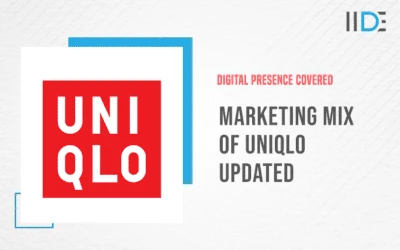
Marketing Mix Of Uniqlo with Updated Company Overview and Explanations
by Aditya Shastri | May 15, 2024
Uniqlo is a Japanese clothing brand known for its high-quality essential pieces formed from the...
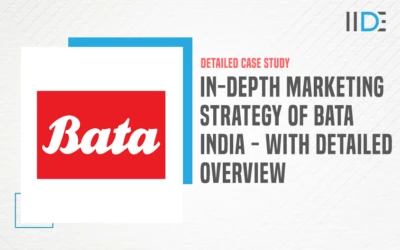
In-depth Marketing Strategy of Bata India – India’s Largest Footwear Company
In this article, we will learn about the marketing strategy of Bata India, the largest footwear...
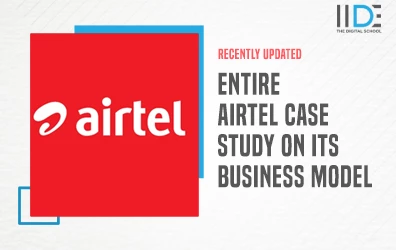
Airtel: Case Study on its Business Model and Marketing Strategy
Bharti Airtel is one of the three telecom giants of India, known for its distinct and engaging...
" * " indicates required fields
I’m Interested in This Masterclass
By providing your contact details, you agree to our Terms of Use & Privacy Policy

- TOP CATEGORIES
- AS and A Level
- University Degree
- International Baccalaureate
- Uncategorised
- 5 Star Essays
- Study Tools
- Study Guides
- Meet the Team
Marketing Mix: Case Studies
Learn about these real life business case studies by reading this analysis and looking at the sample essays.
- MAIN CONCEPTS
- CASE STUDIES
Ford offer a wide range of vehicles including small run-arounds, people carriers, pick up trucks, sporty cars and commercial vehicles of many types and sizes. Within each of their models they often offer a range of options such as hatchbacks, 5 doors and a range of colours. In this way, Ford hope to be able to have a vehicle to meet the need of almost any consumer, and so meet the need of a very wide range of target markets. Ford will regularly apply the product life cycle and Boston Matrix to analyse what changes it needs to make to its product range.
Price:
Ford prices are comparable with the other leading car manufacturers. Some car manufacturers use ‘psychological’ pricing techniques, for example £11,995 is said to look more attractive than £12,000. A very low price would not cover Ford’s costs and would suggest lower quality.
Ford use above the line methods with their TV, newspaper and cinema advertising. They also use below the line methods as they sponsor sporting events (e.g. the Champions League), and are involved in charitable work. This helps to convey their image as a caring and high quality company.
Ford sell their cars through a network of independently owned dealers as retailers are known in the car business. This enables Ford to have a wide geographical spread, without having to be directly involved in the selling of cars.
Car Manufacturer Marketing Essays
The Promotional Mix used by Ford and Apple to Market their Products.
I will describe how marketing techniques are used by BMW to increase the demand for their 7 series luxury model.
Tesco sell a wide range of groceries. They sell all the leading brand’s products like Kellogg’s, Heinz and Nestle, as well as their own brand products, which are made for them by manufacturers who will add the distinctive Tesco packaging. They hope to be able to cater for all customers by adopting a ‘good, better and best’ approach. This means that they offer a basic value Tesco brand, a standard Tesco brand and a range of Tesco Finest products, as well as ‘Healthy living’ and organic. They are also diversifying their product range away from groceries and into many other areas, including clothing, electrical, computing, banking and insurance. This is to take advantage of their established brand name and meet the need of as many customers as possible.
Tesco aims to compete with the other supermarkets by offering ‘money off’ vouchers if the same products could have been bought at a leading rival cheaper. As such, it is not trying to be cheaper than its rivals but the same. It also needs to be aware of how the main discounting supermarkets are doing, and this may affect its future pricing policy. Prices at the smaller convenience stores can be higher than in the supermarkets to reflect the difference in costs.
Tesco uses above the line promotion with its TV advertising. It also uses below the line promotion. Its Clubcard allows it to keep close track on individual customers and offer very specific promotions. It also tries to involve itself in the community with its links with charities such as Diabetes UK, the race for life. This is to enhance its image as a caring company.
Place:
Tesco is widely spread geographically across the UK and has established itself in other European and Asian countries through buying supermarket chains and expansion. In the UK, it has stores of many different sizes from its Tesco Extra hypermarkets to its Tesco Express and One Stop mini stores. It also uses internet shopping where, for a small extra charge, customers can buy online and get their shopping delivered. Tesco acts as its own wholesaler by having its own distribution centres which buy in bulk from the manufacturers and distribute to the individual stores.
Tesco Marketing Essays
How has tesco achieved Competitive advantage
Aims of tesco
Lewes Chimney Sweep
Lewes Chimney Sweep offers a service. That is sweeping chimneys for open fires and wood burners, as well as removing bird’s nests from chimneys. An important part of the product here is the quality, the certificate which can be used for insurance purposes, guaranteed cleanliness and a pleasant personality. This is a growing market, as more people have fires. The wood burner side of it is particularly expanding as people look for more efficient heating.
The price charged is the same as other sole trading chimney sweeps charge. This is because the owner does not want to start a price war, and feels that the price adequately reflects the cost of providing the service. At £39, there is an element of psychological pricing in keeping it below £40. He offers a discount for more than one chimney at the same address as his costs are then lower.
Lewes Chimney Sweep advertises in the local free magazine during the autumn. He also relies on word of mouth, ensuring that customers are left with his card. He comes out first if someone googles Lewes and chimney sweep which he feels brings in business.
This is comparatively simple as it must be in people’s homes. Going into people’s homes does affect the product however, as there must be an air of professional friendliness.
SME Marketing Essays
Produce a Marketing Plan for a small Retail Business.
The aim of this assignment is to investigate setting up of a small business.

IMAGES
VIDEO
COMMENTS
From one juggernaut to another, now we will describe Apple's marketing mix according to product, price, promotion, and place. Product Apple's product mix is mostly confined to consumer electronics and online services. As is the case with Amazon, however, Apple is expanding into other industries. The current product mix consists of: Most of these products […]
McDonald's marketing mix (4Ps) involves approaches that meet business objectives in different markets around the world. The marketing mix defines the strategies and tactics that the fast-food restaurant company uses to reach target customers, in terms of products, place, promotion, and price (the 4P). In this business analysis case, McDonald ...
Diet Coke- In several markets, Diet Coke is referred to as Coca-Cola Light. A calorie and sugar-free soft drink. It was first introduced in 1982. Coca-Cola Zero: Introduced in 2005, this sugar-free beverage became a million-dollar brand in 2007. The product mix of Coca Cola includes: Carbonated Soft Drinks.
Marketing mix. The 4Ps - Product, Price, Place, and Promotion, are what make up the marketing mix. It is an integral tool used to know a company's marketing approach. This model aids us in gaining a broad knowledge of the company and the tactics it employs to advertise and sell its products to the general audience.
Let us view each of the 7Ps of IKEA's Marketing Mix: 1. Product Strategy of IKEA. IKEA has always come up with unique ways to cope up with the dynamic business environment. The product line of IKEA includes the following items in its product portfolio: Furniture (outdoor, indoor, storage) Baby & children's products.
Marketing mix analysis refers to the tools used by a corporation to attend to the targeted customers in the aspect of the 4Ps - products, pricing, place, and promotion. marketing mix of McDonald's consists of several strategies that address the corporation's problems in the fast-food restaurant markets globally. 1.
This article explains the difference between 4P and 7P, explains each facet of the marketing mix with numerous examples, and ends with a detailed case study. To go even further, we suggest you consult our online resource , where we detail and illustrate all the factors to study for each of the 7Ps.
Netflix's marketing mix establishes strategic decisions for the company's products, prices, places, and promotion (the 4Ps). The company's effective development and implementation of the 4P ensure profitable operations in the global market for entertainment and streaming services. This marketing mix and related marketing strategies and ...
Open up with a summary that communicates who your client is and why they reached out to you. Like in the other case study examples, you'll want to close out with a quantitative list of your achievements. 16. " NetApp ," by Evisort. Evisort opens up its NetApp case study with an at-a-glance overview of the client.
Without going into details about the methods, it's another typical third-person case study designed to build trust. 6. Video marketing case study: L'Oréal and YouTube. In this case study, various members of L'Oréal's global marketing team break down exactly how they used YouTube ads to launch a new product.
BMW's marketing mix involves the variables of product, price, place, and promotion (4Ps) used for the automotive and motorcycle business. The company's marketing strategy sets the premium branding used in this marketing mix for the automotive and motorcycle markets. BMW's 4P tactics ensure the premium status of the company's brands ...
Extended Marketing Mix (7 Ps) Commonly used in traditional marketing, extended marketing mix, also known as the 7 Ps of marketing (Product, Place, Price, Promotion, People, Process, Physical Evidence), can also be applied to digital marketing. To get an idea of how the 7 Ps are used in the real world, read this case study of what McDonald's ...
Using the marketing mix in the fashion industry. Ben Sherman is a globally recognised lifestyle brand. It has grown from its business beginnings in quality shirts in Brighton in 1963 and is... 1 2 Page 1 of 2. Learn about the marketing mix in the business studies curriculum, see real-life examples within our case studies with downloads.
1. Tiny cog, big machine. The whole engagement is vast, and the ultimate output is a tool that the client uses to make a first pass at global marketing spend allocation by country, brand, and channel. The aim of these marketing mix models is to produce the response curves that fuel the allocation tool's engine.
McDonald's employs the four pillars of marketing mix, which are as follows: Product: A product is a tangible item or service that a firm provides to its customers. Packaging, guarantee, and appearance are all characteristics of a product. It is also the physical and non-physical part of the product, consumers have the right to spend their ...
1 Define and describe the marketing mix. 2 List and explain the 4Ps of marketing. Marketing Mix Defined. Having a great product or service is just the first step in establishing a successful business or building a successful brand. The best product or service in the world won't translate to profits unless people know about it.
3 Google-commissioned Nielsen MMM Meta-Analysis, U.S., studies completed between 2015-2017 (pre-period) and 2019-2020 (post-period), base: a list of MMM studies selected and compiled by Nielsen, consisting of 132 brand/category combinations that collaborated with Google on MMMs as well as 140 brands that did not collaborate with Google, 2015 ...
Try to keep your headline under 12 words. Use action words: Incorporate action verbs such as "achieved," "transformed," or "boosted" to convey a sense of accomplishment. Include data: Numbers make your headline more credible. For example, if the case study achieved a 75% increase in sales, include that in the headline.
the most important elements to increase the customer satisfaction (95.4%) and (93%) respectively. The promotion of product has a very good level to increase sells in the company (80.6% - 85%). The ...
The paper aims to investigate the influencing of marketing mix (MM) elements (product, price, place or distribution, and promotion) on increasing the effectiven ... Thabit and Raewf, Manaf, The Evaluation of Marketing Mix Elements: A Case Study (March 1, 2018). International Journal of Social Sciences & Educational Studies, March 2018, Vol.4 ...
A Marketing Mix Model is a modeling technique used to determine market attribution, the estimated impact of each marketing channel that a given company is using. Unlike Attribution Modeling , another technique used for marketing attribution, Marketing Mix Models attempt to measure the impact of immeasurable marketing channels, like TV, radio ...
This has helped the company to be one of the leading sportswear brands in the world in order to generate higher sales. 4. Marketing Mix of Adidas: Promotion Strategy. This one is the most important part of the Adidas marketing mix strategy. It is a well-known fact that the TV ads of Adidas are Adrenaline pumping.
SME Marketing Essays. Produce a Marketing Plan for a small Retail Business. The aim of this assignment is to investigate setting up of a small business. See More…. 19.1K. 139. Check out our marketing mix case studies covering Ford, Tesco and SMEs, all complete with example essays.
of the MM. According to the marketing literature, we think that 4Ps developed over time according to the needs of the practices of organizations, and MM become strategically in a good position in the marketing plan. 3.1 The Concept of Marketing Mix MM can be defined as controllable group of variables that the organization can use to effect on the